Apollo 13
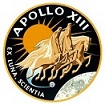
Day 3, part 3: Aquarius Becomes a Lifeboat
Corrected Transcript and Commentary Copyright ©2019-2020 by W. David Woods, Johannes Kemppanen, Frank O'Brien, Alexander Turhanov and Lennox J. Waugh. All rights reserved.
Last updated 2020-06-10
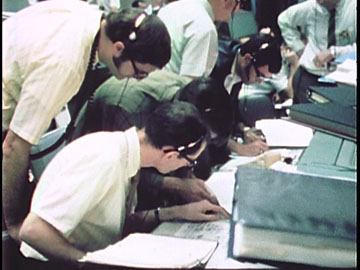
Flight Controllers working the problem at their stations.
057:23:54 Swigert: Okay, Jack. It looks like O
2 tank 1 pressure is just a hair over 200.
057:24:02 Lousma: We confirm that here and the temperature also confirms it.
057:24:09 Swigert: Okay. Does it look like it's still going down?
057:24:12 Lousma: It's slowly going to zero, and we're starting to think about the LM lifeboat.
057:24:20 Swigert: Yes. That's what we're thinking about, too. You want me to do a quick P52? It kind of looks like - We've been talking it over, and it kind of looks like we'd probably align our plats - LM platform with our platform and then power down the CM, and keep the LM powered up doing a DPS - whatever DPS burns you give us? [Pause.]
057:24:54 Lousma: 13, we're not going to concern ourselves at the moment with a DPS burn. It's going to be some time before we'd get to that; but we're working on other procedures to give you, which will allow us to use the LM systems. Over.
057:25:12 Swigert: Okay. Real fine.
057:26:40 Lousma: Apollo 13, Houston. We'd like to charge battery A now.
057:26:46 Lovell: Charge battery A. Roger. [Long pause.]
057:27:13 Lousma: And, Jack, in regards to your question about the P52 and LM platform, it's - There's no need to worry about that now. We wouldn't be using the LM platform for - until about 79 hours, so let's go as is on the platform for now. Over.
057:27:30 Lovell: Okay. We understand.
057:27:37 Swigert: Okay, Jack.
057:28:36 Burton (EECOM): FLIGHT, we're not going to have anything in about 40 minutes here.
057:28:49 Burton (EECOM): FLIGHT, EECOM.
057:28:56 Burton (EECOM): FLIGHT, EECOM.
057:28:58 Lunney (FLIGHT): Go ahead.
057:28:59 Burton (EECOM): Okay, we’ve got an update on the time. Looks like we’ve got about 18 minutes until we get down to 100 psi, and that’s the cutoff point.
057:29:05 Lunney (FLIGHT): Alright, but we’re charging Battery A.
057:29:07 Burton (EECOM): Well, that doesn’t mean much in 18 minutes, though. But we’re doing all we can do.
057:29:10 Lunney (FLIGHT): Alright.
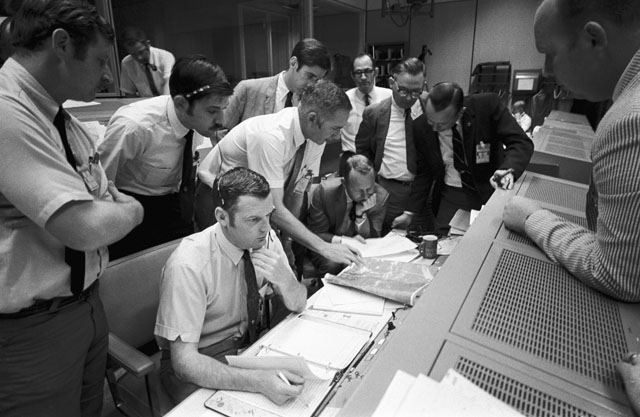
Flight Director Glynn Lunney photographed at his position in Mission Control.
057:30:13 Swigert: And, Jack, we've turned off the waste dump heater. If you're going to consider dumping any more waste water, we probably ought to do it while the duct is warm there.
057:30:30 Lousma: Roger. Stand by, Jack.
057:30:38 Lousma: Okay, Jack. Let's keep the water; no need for a dump right now.
057:30:44 Swigert: All right.
057:32:04 Lunney (FLIGHT): EECOM, FLIGHT.
057:32:05 Burton (EECOM): 'head, FLIGHT.
057:32:06 Lunney (FLIGHT): Let me try one more time. Is it possible that if we got power to Main B that we could get, uh, Tank 2 powered up, and up in pressure?
057:32:17 Burton (EECOM): We don't feel like that’s a possibility, FLIGHT. We might conceivably get power to B but we don't feel like we can get anything out of Tank 2.
057:32:24 Lunney (FLIGHT): Okay now why is that? Tell me why. I'm just working the situation.
057:32:27 Burton (EECOM): It's because the numbers we are looking at indicate that it’s essentially, uh, uh, ambient.
057:32:35 Lunney (FLIGHT): Okay.
057:32:15 Lousma: 13, Houston. We see the Prop Isol valve on RCS quad Charlie closed, so we'd like to also disable Auto RCS feature in quad Charlie.
057:32:30 Lovell: You want to isolate the Auto RCS features in quad Charlie ?
057:32:33 Lousma: Affirmative. [Pause.]
057:32:44 Lovell: Okay, Jack. I didn't plan to reset that quad Charlie Prop Isol valve. Do you want me to do that? Okay. We just tried it and quad Alpha and Charlie barber poles are showing.
Lunney (FLIGHT): Aaah... EECOM, FLIGHT.
Burton (EECOM): Go, FLIGHT.
Lunney (FLIGHT): How long we got now in the cell?
Burton (EECOM): Last account we had 18 minutes - let me get an update.
Lunney (FLIGHT): Okay, TELMU, what have we got to do to power up to get some comm on the LM?
Merritt (TELMU): Okay, FLIGHT. We've got a procedure here that gets power up first on the LM.
Lunney (FLIGHT): Yeah.
057:33:01 Lousma: Stand by, Jim.
057:33:03 Swigert: Okay, Jack. That's the sec - secondary propellant barber poles on Alpha and Charlie.
057:34:47 Lousma: 13, Houston. It won't do any good to try to power the propellant valves on A and C, so we want you to disable the Auto on RCS Charlie. And we have a procedure for getting power from the LM we'd like you to copy down.
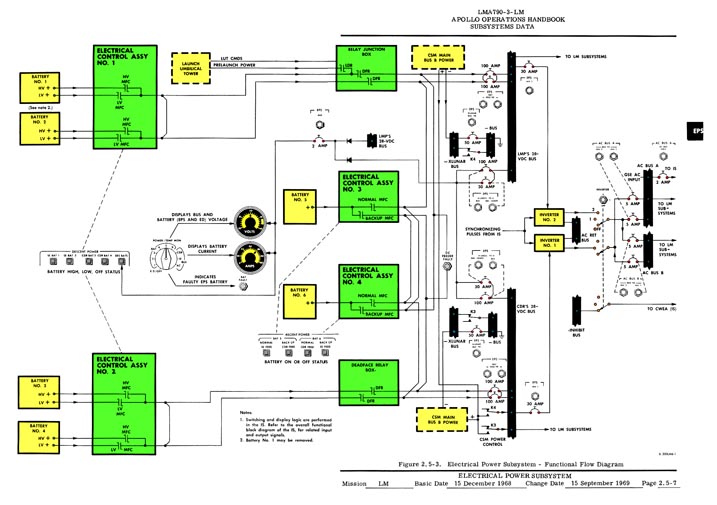
Diagram of the LM Electric Power System. From the Apollo Lunar Module Operations Handbook, Vol 1. Colored for AFJ.
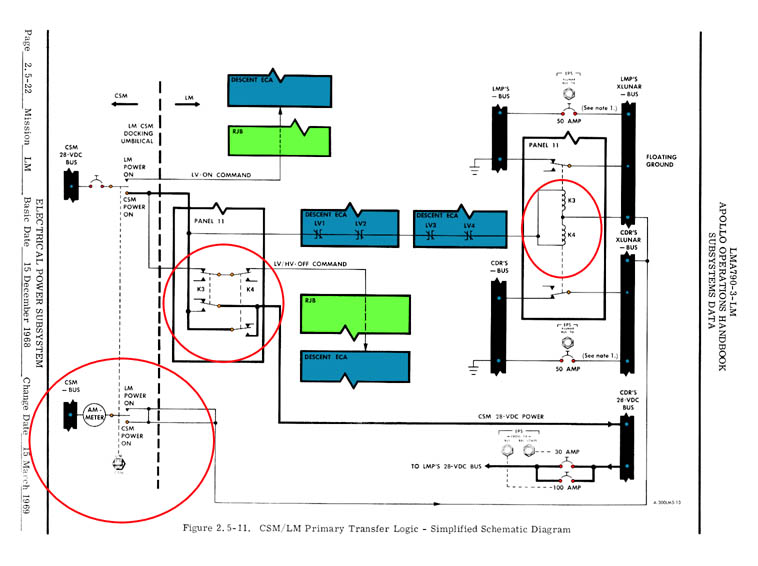
Colored and modified from the original Apollo Lunar Module Operations Handbook, Vol 1.
057:35:09 Lovell: Stand by, Jack.
057:35:11 Swigert: That sounds like good news. [Long pause.]
057:36:05 Haise: Okay, Jack. About how long is it?
057:36:12 Lousma: It's not a very long procedure, Fred. We figure we've got about 15 minutes worth of power left in the Command Module, so we want you to start getting over in the LM and getting some power on that. And, you ready to copy your procedure?
057:36:29 Lousma: Okay. In the CSM.
057:36:30 Haise: Stand by. [Pause.]
057:36:40 Haise: Go ahead.
057:36:41 Lousma: Okay. In the CSM on panel 5, circuit breakers LM Power 1 and 2, Open. Then LM Power switch, reset and release. In the LM, on panel 11 and panel 16, Translunar Bus Tie. Both circuit breakers Close. On panel 16, circuit breaker Ascent ECA Control, Close. On 16, Descent ECA Control, Close. On panel 14, put your Bat 5 Normal feed On. BATs 1, 2, 3, and 4 Low Voltage taps, On. Bat 5 Normal feed, Off. Ascent ECA Control, Open. You copy?
057:38:08 Haise: Stand by one. [Long pause.]
057:38:24 Haise: Okay. In the CSM, on panel 5, we want CB LM Power 1 and 2, Open. Then the LM Power switch to reset, release. In the LM, panels 11 and 16, X Lunar Bus Tie breakers closed. On panel 16, the Ascent ECA Control closed; the Descent ECA Control closed. On panel 14, Bat 5 Normal feed On, followed by BATS 1, 2, 3, and 4 Low Voltage taps On. Then Bat 5 Normal feed Off. Then Ascent ECA Control breaker Open.
057:38:58 Lousma: That's a good readback, Fred. [Pause.]
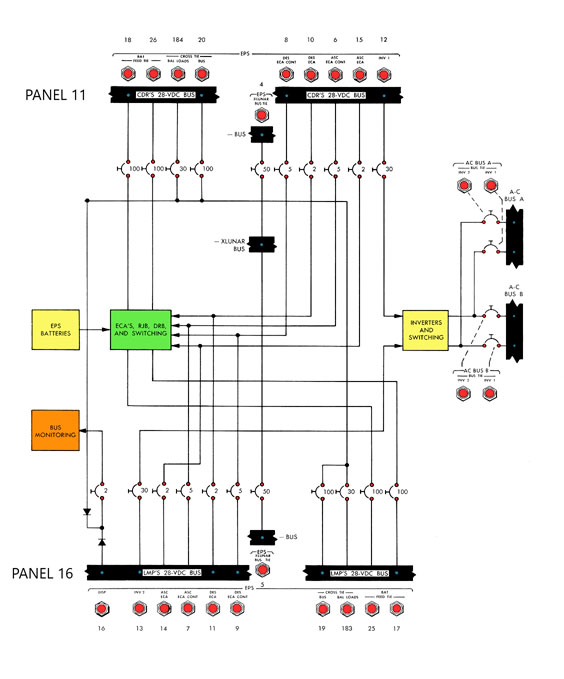
LM Electric Power System control circuits. Click image for a larger view.
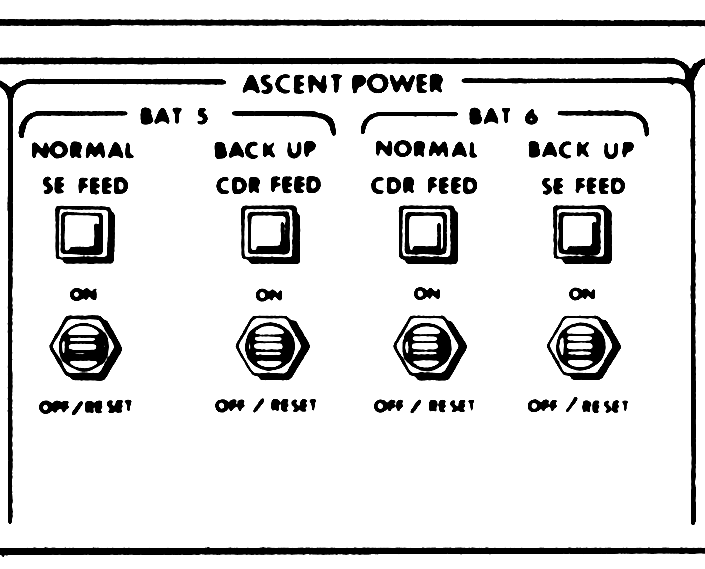
LM Ascent Battery controls. Scan via heroicrelics.org
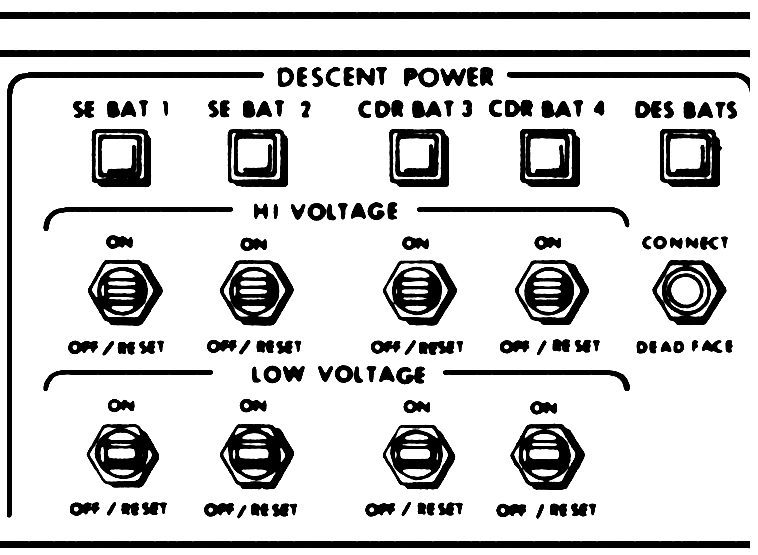
LM Descent Battery controls. Scan via heroicrelics.org
057:39:13 Ground technician: No.
057:39:14 Lousma: And, 13, Houston. As a final effort here, we would like you to turn on the fans in tank 2. Over.
057:39:23 Lovell: Roger. Understand. Turn on the fans in tank 2. [Pause.]
057:39:34 Lovell: You want the O
2 fans in tank 2, Jack?
057:39:38 Lousma: That's affirmative, Jim.
057:39:39 Ground technician: Understand.
057:39:45 Lovell: O
2 tanks - fans in tank 2 are on.
057:41:31 Lousma: 13, Houston. We'd like you to start making your way over to the LM now.
057:41:38 Swigert: Fred and Jim are in the LM.
057:41:42 Lousma: Okay, Jack. Thank you.
057:41:47 Haise: And, Jack, I got LM power on.
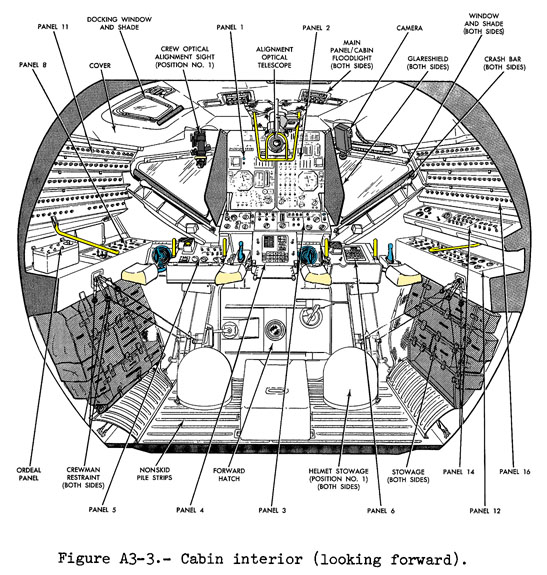
Schematic diagram of the LM cockpit, facing forward.
057:42:50 Swigert: Okay. You still with us, Houston? [Pause.]
057:43:03 Swigert: Okay, Houston. You read 13?
057:43:06 Lousma: Reading you loud and clear, Jack. I've got a procedure for...
057:43:11 Lousma: ...the guys in the LM.
057:43:15 Swigert: You got another one?
057:43:17 Lousma: I have an activation procedure. I'd like you to copy it down. [Pause.]
057:43:25 Haise: How long is it, Jack?
057:43:27 Lousma: It's just four lines. Go to Activation 1, do step 3. Go to Activation 11, omit step 1. Do Activation 12, and then go to Activation 13 and do step 1. Do you copy?
057:43:54 Lovell: Okay. Is that Activation 1? Do step 3. Is that correct?
057:43:59 Lousma: That's affirmative, Jim.
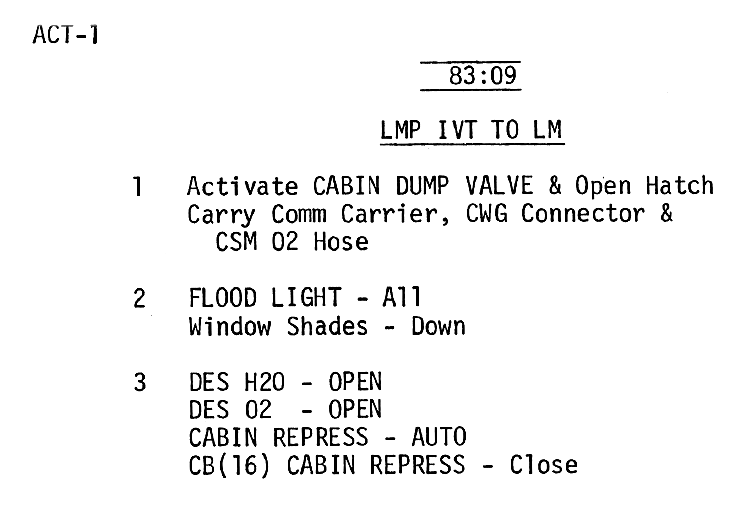
Activation 1
057:44:03 Lovell: Activation 11, omit step 1, do the rest. Is that correct?
057:44:06 Lousma: That's affirmative.
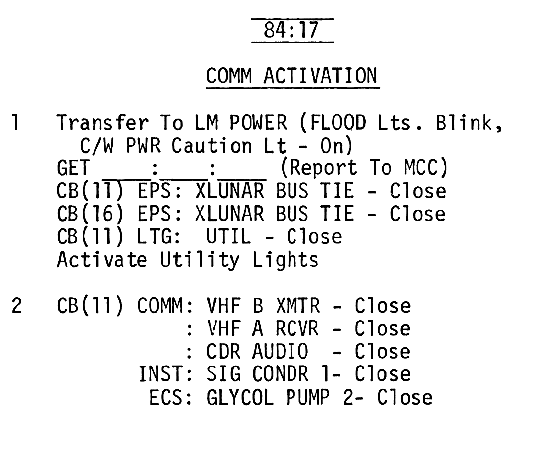
Activation 11
057:44:12 Lovell: Do Activation 12 and Activation 13, step 1.
057:44:14 Lousma: That's all correct. [Pause.]

Activation 12
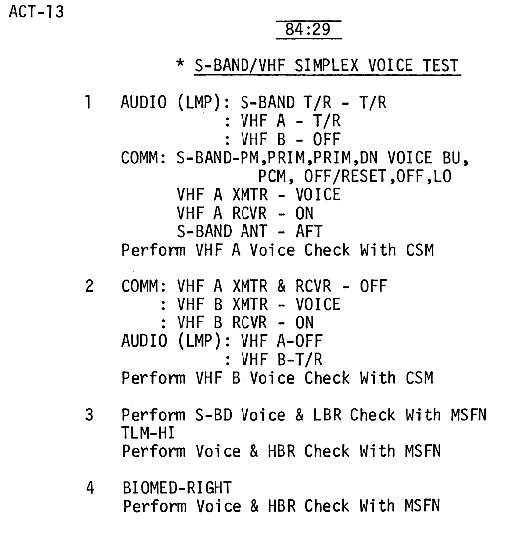
Activation 13
057:44:25 Swigert: Okay, Jack. Pressure in tank 1 is approaching 100 psi. What's going to be the symptoms of this fuel cell starting to drop off? [Long pause.]
057:44:51 Lousma: Stand by, Jack. We'll get the word on that.
057:44:56 Swigert: Okay. [Pause.]
057:45:06 Lousma: And, Jim, when you get to the end of that procedure, we'd also like to have you put the Demand Regs to Cabin.
057:45:15 Lovell: Demand Regs to Cabin. Roger. [Long pause.]
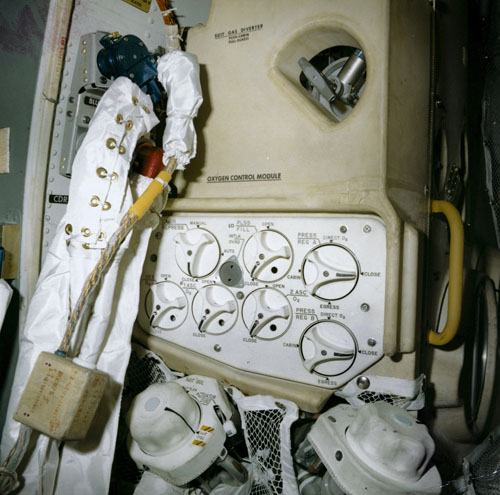
Oxygen system control panel on the aft section of the Lunar Module cabin.

Diagram of the control panel as seen in the photo above.
057:45:31 Lovell: Jack, was that Activation 1, step 3 only, or all of Activation 1?
057:45:38 Lousma: That's go all the way down to step 3, Jim.
057:45:44 Lovell: Activation 1 to step 3. Roger.
This is Apollo Control at 57 hours, 46 minutes Ground Elapsed Time. The Black team of flight controllers is now stationed in Mission Control Center looking at possible alternate missions. As we have an apparent serious oxygen leak in the cyrogenic oxygen in the Service Module. And now in the process of powering down the Command Module in less than 15 minutes remaining of electrical power to the CSM. The Command Module surge tank has been charged with oxygen for entry.
057:46:48 Lovell: Houston, Apollo 13. Never mind.
057:46:54 Lousma: 13, say again, please.
057:46:58 Lovell: Oh, we were curious about Activation 11 on the VHF.
057:47:04 Lousma: Omit the VHF.
057:47:05 Haise: ...[Garble] Jack. It's got - Okay.
In this scheme of going across to the Lunar Module, still connected with the open tunnel, the Lunar Module would serve as a sort of lifeboat for the crew of Apollo 13. Sometime later in the mission it is expected that they would return to the free return trajectory, which they left yesterday in the midcourse burn number 2. At the pericynthion near the Moon they would use the Descent Propulsion System of the Lunar Module for Trans-Earth Injection burn at about 79 hours, 30 minutes Ground Elapsed Time. This would produce a day early entry at about 142 hours. That is a day earlier than a nominal free return entry. We're continuing to monitor the situation and still live on air-ground.
057:48:17 Lousma: Jack, this is Houston. We want you to keep the IMU up and keep the lights on so you can see in there, and leave battery off - battery A off and, at the appropriate time, we'll put it on Main A. And we're going to keep the IMU up so as we can get a coarse align in the LM.
057:48:38 Swigert: All right. Real good. Right now, we're charging battery A. Do you want to discontinue that?
057:48:46 Lousma: Discontinue the charge on battery A, Jack. [Long pause.]
057:49:22 Swigert: Okay, Jack. I discontinued charge on battery A. You give me the call and I'll turn Bus Tie AC on.
057:49:32 Lousma: Roger. And we want you to keep the lights up and the IMU on.
057:49:38 Swigert: Okay. [Pause.]
057:49:48 Lousma: And, Jack, we'd like you to leave the comm configuration as is until we get Comm with the LM.
057:51:08 Lousma: And, 13, this is Houston. I've got another procedure for the LM. A short one.
057:51:15 Lovell: Okay. Ready to copy, Jack.
057:51:17 Lousma: Okay. On panel 11, we'd like you to close the LGC DSKY circuit breaker. Then we want you to go to Activation 25; do steps 1, 2, and 3. Then go to Activation 30, and that will give us a docked IMU coarse align. Over.
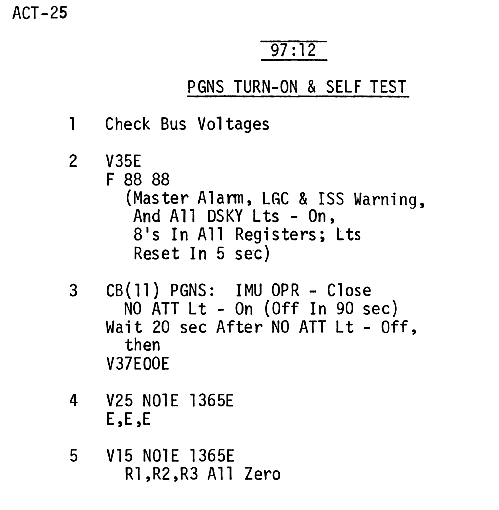
Activation 25 procedure in the Lunar Module Activation Checklist.
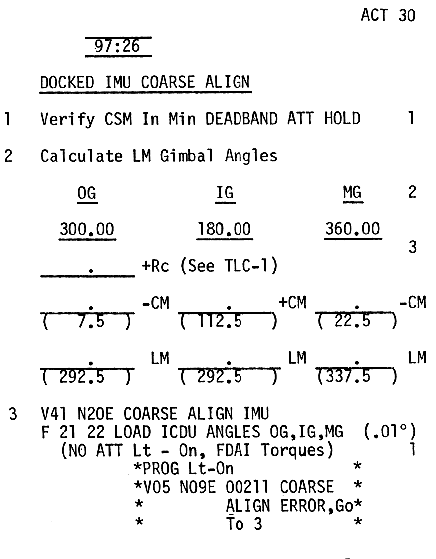
Activation 30 procedure in the Lunar Module Activation Checklist.
057:51:41 Lovell: Roger. Panel 11, close LGC circuit breaker. Activation 25, do steps 1, 2, 3, and then do complete Activation 30. Is that correct?
057:51:50 Lousma: That's affirmative. On panel 11, LGC DSKY circuit breaker closed.
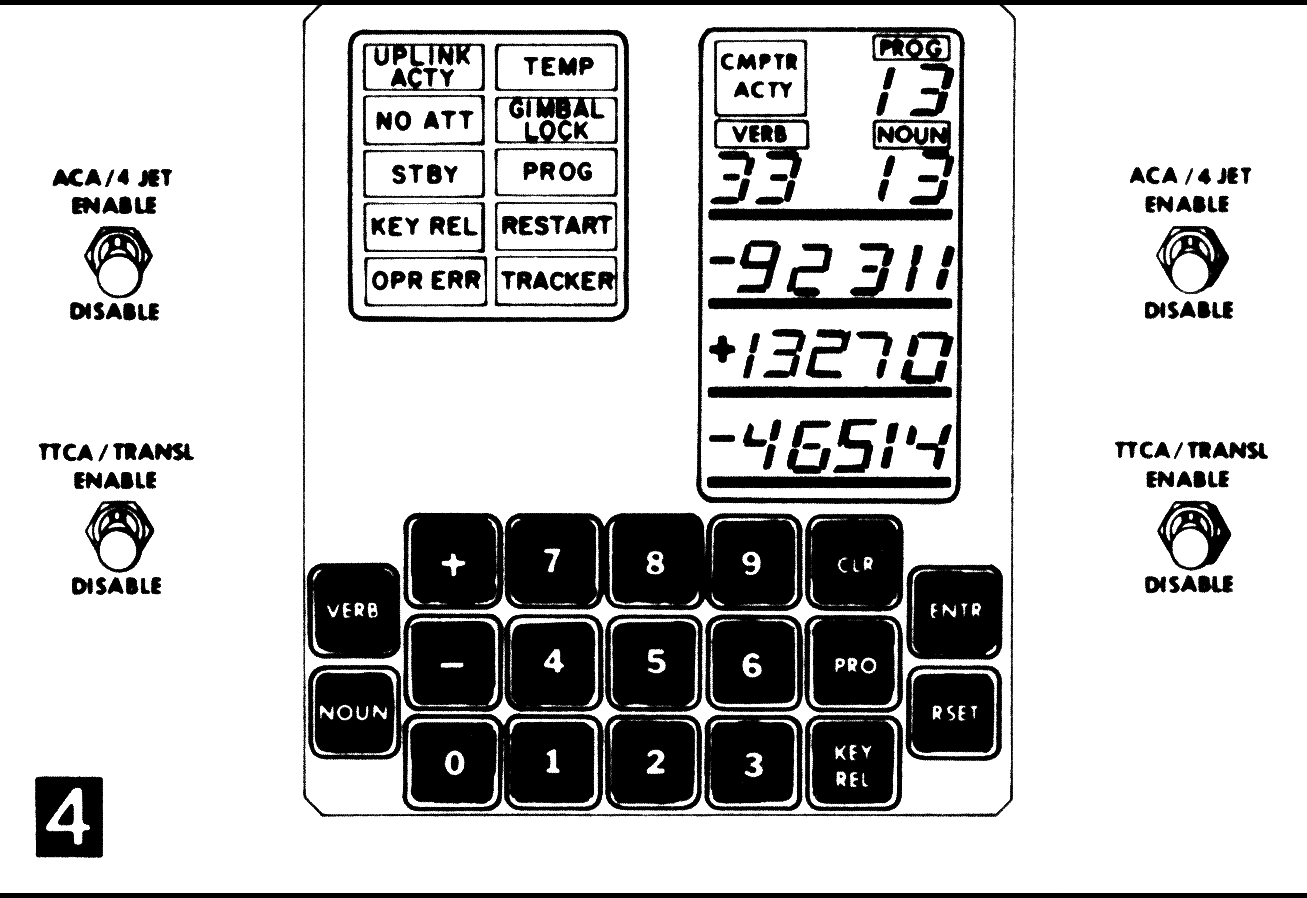
The Lunar Guidance Computer Display and Keyboard (DSKY) in the LM. Panel scan via heroicrelics.org
This is Apollo Control. We have confirmation now that two of the Apollo 13 crewmen are indeed in the Lunar Module.
057:53:15 Lousma: And in the LM, let's go to panel 11 and close the Suit Fan circuit breaker and get suit fan 1 cranked up.
057:53:26 Lovell: Okay. Panel 11, close Suit Fan circuit breaker, and we'll get the suit fan cranked up.
057:53:30 Lousma: That's affirm. [Long pause.]
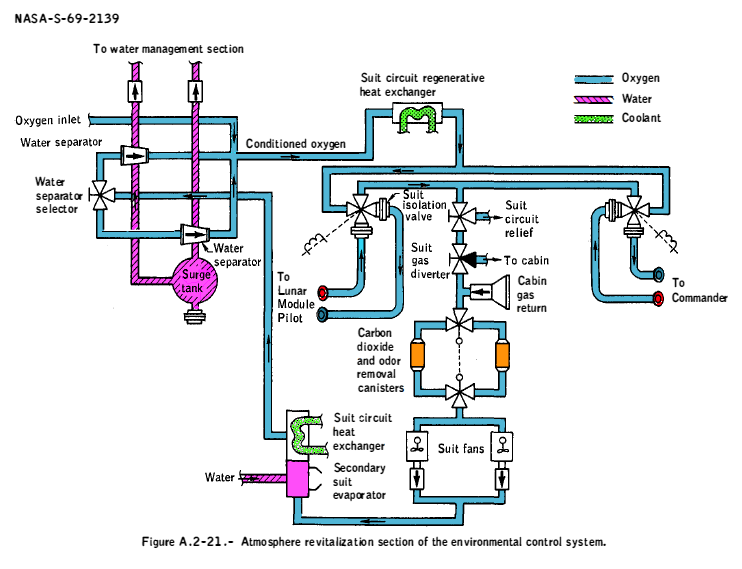
The ARS or Atmospheric Revitalization Section of the LM Environmental Control System.
057:53:47 Lousma: And, Jack, in the CSM, go to Bypass on the radiators and turn your Glycol Pump off.
057:53:56 Swigert: Okay. Pull the Bypass; Glycol Pump going off.
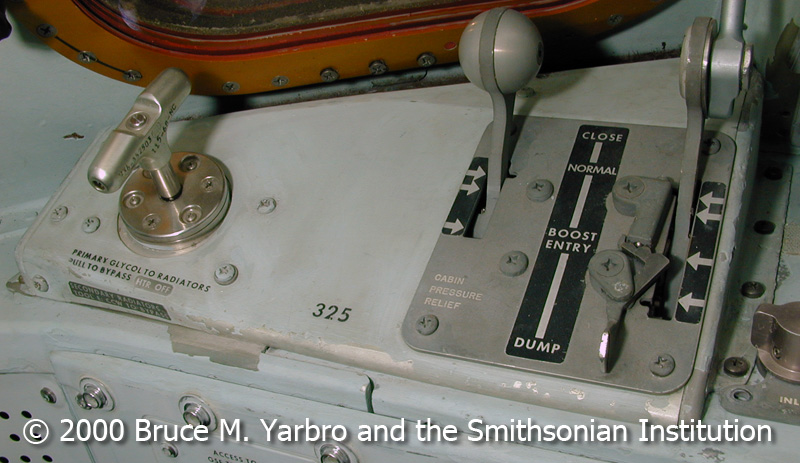
The manual handle for the radiator bypass. Photographed onboard the Odyssey
057:55:42 Lousma: And, 13, in the CSM, we want to verify that all the fuel cell pumps are off, and we want to have you turn off the O
2 fans in the tank 2.
057:55:56 Swigert: Okay. Tank 2 fans going off. Okay. That leaves me with tank 1 fans on the tank 1 heaters on.
057:56:08 Ground technician: That's affirm.
057:56:10 Swigert: Fuel cell 2 pump going off now. [Pause.]
057:56:21 Lousma:And Jack, leave them both on in tank 1.
057:57:28 Haise: Jim [Garble] Verb 37 Enter...Activation 30...[Garble]
057:57:55 Lousma: 13, Houston. We've got AOS on the LM here.
This is Apollo Control at 57 hours, 58 minutes Ground Elapsed Time. To recap briefly the situation here in Mission Control Center; we have an apparently serious problem with a leak in the cryogenic oxygen in the Service Module, which provides the electrical power system coming out of the fuel cells, and also, breathing oxygen for the crew. Now in the process of manning the Lunar Module. Standby.
057:59:23 Lousma: And, 13, this is Houston. In the LM, we'd like to have 12, step 3, which is get the batteries on high taps. Over.
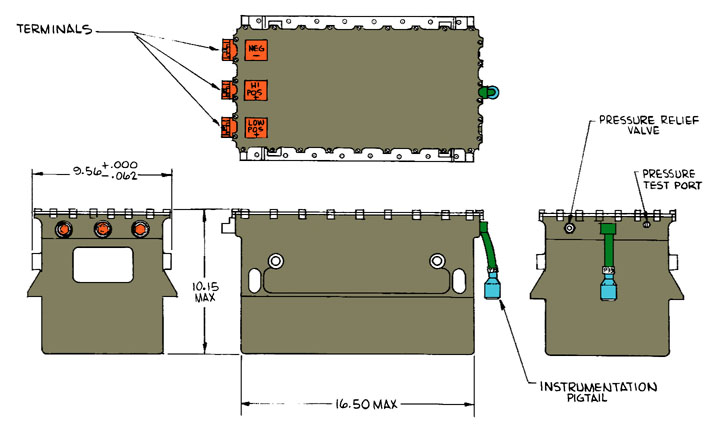
Diagram of a Descent Stage battery.
057:59:41 Haise: How you going there? Activation 12, step 3. [Long pause.]

Descent Battery controls in the LM. Scan via heroicrelics.org
Under this alternate mission, the Lunar Module would serve as a lifeboat to bring the Apollo 13 crew back to Earth. That is its consumables, oxygen, electrical power...
058:00:18 Haise: Okay. And, Jack, how do you read from Aquarius?
058:00:23 Lousma: Aquarius, Houston. Say again, please.
058:00:28 Haise: Okay. I was just making a Comm check here. I'm on high voltage taps.
058:00:32 Lousma: Roger. We see them, Fred, and I'm reading you loud and clear.
058:00:39 Haise: Okay. Didn't think I'd be back (in) this soon. [Pause.]
058:00:51 Haise: Okay. What next, James? Coarse align?
058:00:57 Haise: Do it right. Take your time. [Long pause.]
The current thinking is to use the Lunar Module Descent Propulsion System, a big engine of the LM to propel the entire spacecraft stack to a higher velocity as they go around behind the Moon to come back to Earth a day earlier than a normal free return trajectory would return the spacecraft.
058:01:32 Lousma: And, Aquarius, Houston. We'd like you to, on your alignment, can you continue right on through the fine align Activation 31? Go right on through step 7. Over.
058:01:45 Haise: Okay. You want to go on 31 through step number 7, Jack.
058:01:50 Lousma: That's affirmative. And, Odyssey, we've got another configuration for you. All 16 RCS Auto Select Off. All RCS heaters off. Over.

RCS Auto SELECT switches on Panel 8, Commander's left hand panel.
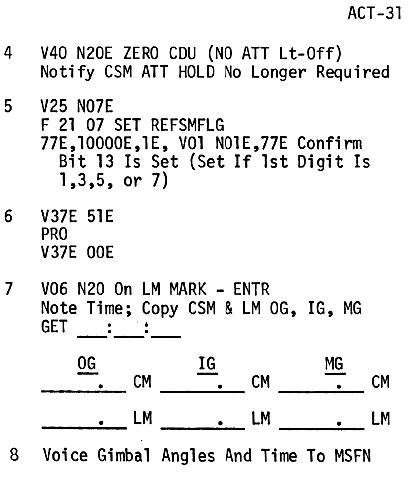
Activation 31, in the Lunar Module Activation Checklist
058:02:06 Swigert: Okay. I can verify all heaters off. Jack, I've got to keep a fairly minimum deadband until I get through this coarse align.
058:02:15 Lousma: Roger. [Pause.]
058:02:26 Haise: Okay. Verb 41, Noun 20. Okay. You want plus? Plus or minus? Plus 302.43? Is that right? [Long pause.]
058:03:12 Haise: Okay. Let me enter it. Okay. What's the next one? Plus 347.78. 347.78. Okay. 08.13. Is that right? Enter. Okay. [Long pause.]
058:03:53 Lousma: Odyssey, Houston ...
Burton (EECOM): Flight, EECOM.
Lunney (FLIGHT): Go ahead.
Burton (EECOM): O2 to N2 delta P is dropping. Let’s turn Battery A on.
Lunney (FLIGHT): CAPCOM, Battery A on. [Pause.]
Lunney (FLIGHT): Tell him to hurry.
058:03:54 Lovell: Houston, [Garble.]
058:03:55 Lousma: ... your battery A on.
058:03:59 Swigert: Battery A on now.
058:04:01 Lousma: Go ahead, Aquarius.
058:04:03 Lovell: Houston. Okay. I want you to double check my arithmetic to make sure we got a good coarse align. The Roll Cal angle was minus 2 degrees. The Command Module angles were 355.57, 167.78, 351.87. [Pause.]
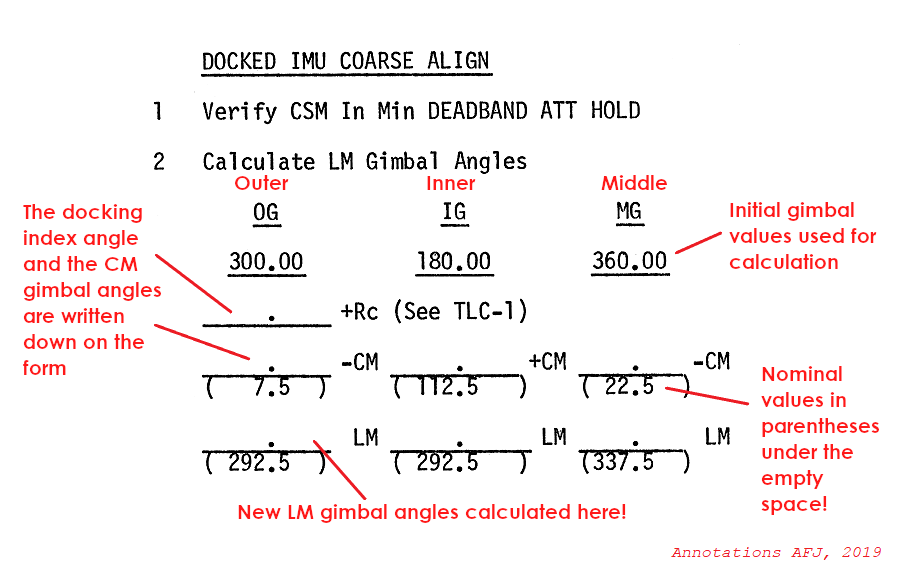
The Coarse Align sheet annotated
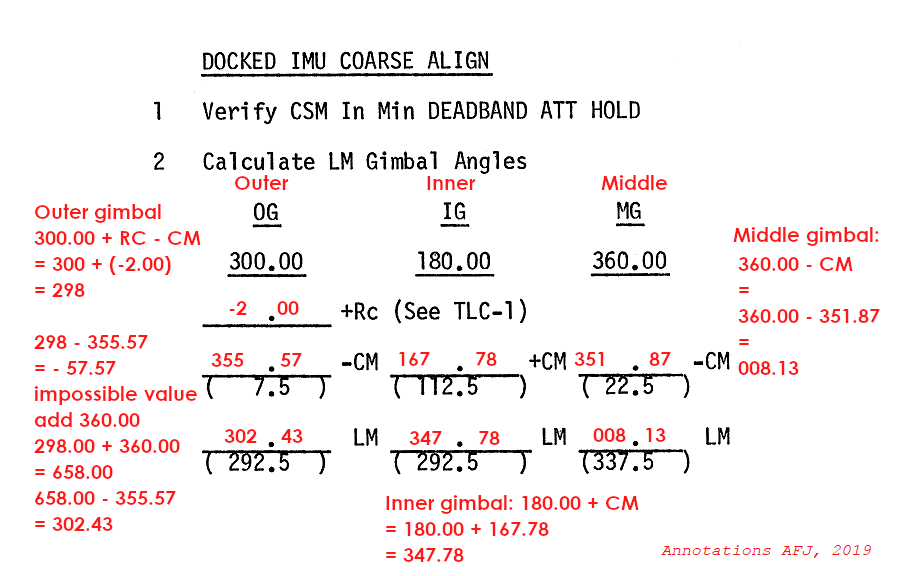
The Coarse Align sheet with the values and the calculations annotated.
058:04:36 Lousma: Okay, Jim. We copy the roll CAL at minus 2.0. The Command Module is 355.57, 167.78, 351.87. [Long pause.]
058:05:19 Haise: Okay. Verb 41, we've done that. Okay.
058:05:27 Lousma: Aquarius, Houston. Request high bit rate, please.
058:05:36 Haise: You want high bit rate?
058:05:38 Lousma: That's affirmative, Fred. Won't cost us anything. [Long pause.]
058:06:22 Lousma: Odyssey, Houston. We'd like you to, on your Comm configuration, go to Primary Power Amp Off, Low Bit Rate, and Down Voice Backup. Over.
058:06:42 Lousma: And, Aquarius, we need your Suit Gas Diverter to Cabin. [Pause.]
058:06:55 Haise: All right. You got it.
058:07:02 Swigert: Houston. I've gone to Primary Power Amplifier, Off, Low Bit Rate, Down Voice Backup.
058:07:11 Lousma: Okay, Jack. Thank you. And, Aquarius, your arithmetic looks good on the coarse align, there.
058:07:20 Lovell: Okay. Okay stand by for an Enter.
058:07:26 Lovell: Three... [Pause.]
058:07:39 Swigert: Get the GET; we need the GET. What is it? What's that? 58? 58:07? [Long pause.]
058:08:15 Swigert: 58 what?
This is Apollo Control. Apollo 13 crewmen Jim Lovell and Fred Haise are just completed...
058:09:16 Lovell: Houston, Aquarius.
058:09:18 Lousma: Go ahead, Aquarius.
058:09:23 Lovell: Here are the gimbal angles. Command module, 356.69, 163.42, 346.67. Aquarius is 302.26, 345.92, 011.79. Over.
058:09:47 Lousma: Okay, Jim. I got Command Module 356.65, 163.42, 346.67. Aquarius, 302.26, 345.92, 011.78.
058:10:07 Lovell: That's 011.79.
058:10:11 Lousma: Say again, please.
058:10:17 Lovell: The LM middle gimbal is 011.79.
058:10:22 Lousma: 011.79. Got it.
Those angles being read back from Aquarius and from Odyssey were from the coarse alignment of the Lunar Module guidance system platform. Returning to the alternate mission now being considered, the Descent Propulsion System Trans-Earth Injection burn would take place at about 79 hours, 30 minutes Ground Elapsed Time. Producing an entry at about 142 hours. At this point in the translunar coast, it is cheaper and swifter to coast on around the Moon and come back to Earth than it is to do a deep space abort. Continuing to monitor air-ground from Apollo 13, this is Apollo Control.
058:12:10 Swigert: Houston. [Garble.] flashing.
058:12:19 Lousma: Odyssey, Houston. We need a command reset on your - on your Comm, and then we'd like you to power down to CMC, power down the IMU, heaters off on the IMU, but leave the battery A on.
058:12:43 Swigert: Yeah. [Long pause.]
058:12:58 Lousma: Odyssey, Houston. [Pause.]
058:13:07 Swigert: Ask him if he's - Are you reading?
058:13:11 Swigert: Are you reading, Houston?
058:13:13 Lovell: Houston, this is Odyssey. Go ahead.
058:13:16 Lousma: Okay, Jim...
058:13:18 Swigert: Copy it down.
058:13:20 Lousma: Okay, Jim. I think I'm reading Jack, now. But what we want him to do is to give us a command reset. And then power down the CMC, power down the IMU, turn the IMU heater off, leave battery A on. Over. [Long pause.]
058:14:19 Haise: That's just about 80 - in fact, 82 hours out of the two primary cartridges. That's two guys. 24 is what LTA got. That would be 88 hours. We got a secondary. You're right. We're listening.
058:14:41 Lousma: Odyssey, Houston.
058:14:43 Swigert: They can stand it - Go ahead?
058:14:47 Lousma: Yeah, Jack. Did you copy down about the CMC IMU?
058:14:52 Swigert: Yes, Jack. I read it back twice to you. Command reset, which I've done. I'm about to power down the IMU, power down the CMC, turn the IMU heaters off, leave Bat A on.
058:15:07 Lousma: That's affirm. Thank you.
058:15:11 Swigert: Okay. I just got a Master Alarm and Main Bus A Undervolt. And I'm starting to power down, now...
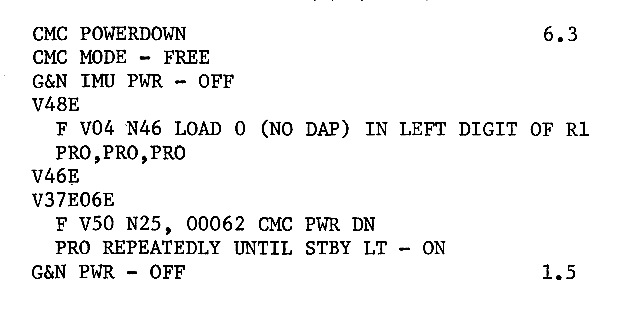
The Command Module Computer (CMC) and Inertial Measurement Unit (IMU) emergency power-down procedure
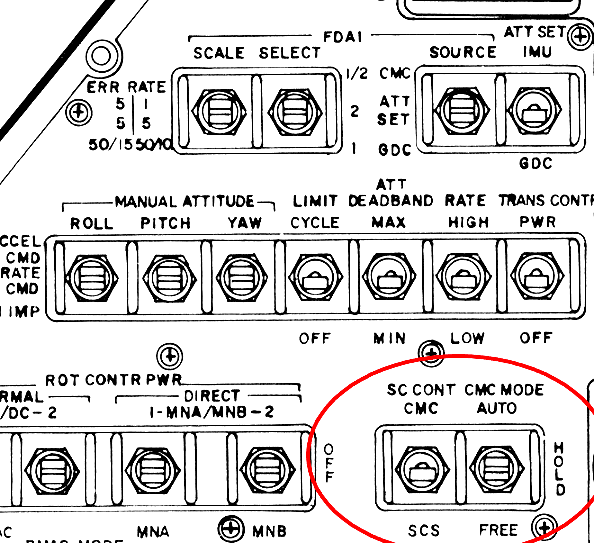
Attitude control selection switches on the MDC. Original scan via heroicrelics.org
058:15:21 Haise: We've lost - The only advantage to doing it early; if we can power back - the LM back down. The only advantage doing it early is you can do a big burn now and a midcourse and then power the LM down. Otherwise, we got to keep the LM powered up clear until we get around the Moon. Plus it would be inside on the burn. I just hope the G&N hangs up on ... hangs in on this one - I'd sure hate to do that one manually.
058:16:05 Lovell: Oh boy.
058:16:06 Lousma: Odyssey, Houston. Couple circuit breakers for you. On panel 276, on our Instrumentation Power Control, open CB number 3 and number 4. [Pause.]
058:16:33 Swigert: Okay, Houston. Panel 276, Instrumentation out and reset...
058:16:39 Swigert: ...a lot of light.
058:16:40 Haise: ...CB-3 and CB-4 are open.
058:16:47 Lousma: That's affirmative, Odyssey. and also get your SCS electronics package and power off, and your FDAI Power/GPI off, and your Auto JET SELECT, all 16 off.
058:17:07 Swigert: Okay. Well, wait a second. Let me - Let me get the CMC power down.
058:17:13 Lousma: Roger, Jack.
058:17:16 Haise: I wonder how much that's going to bring this up, here.
058:17:23 Lovell: Jack, while he's doing that, copy down what you just said again. I want to write it down. [Pause.]
058:17:36 Lousma: Aquarius, we need to get your sublimator powered up, Activation page 20 and Activation page 21, step 3. Over.
058:17:52 Lovell: Roger. Activation page 20 and Activation page 21, step 3, sublimator.
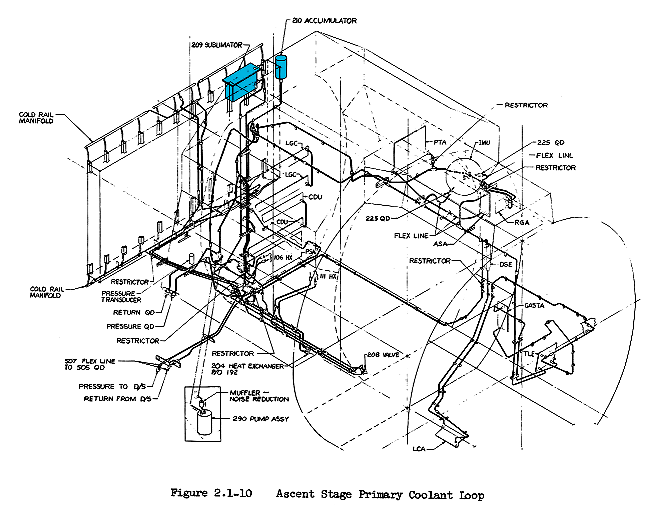
A diagram of the Ascent Stage of the LM with the various coolant pipes and tubing indicated. The primary and secondary sublimator are highlighted.
058:18:00 Swigert: That's Activation, page 20? Okay, Jack. Now I have to power down IMU. I have no control at all. I'm going to turn my 16 jets off. Say again the other things you wanted?
058:18:24 Ground technician: That's that O2 tank 1 heaters and fans.
058:18:28 Lousma: Okay, Jack. We'd like you to turn off your O
2 tank 2 heaters and fans.
058:18:31 Ground technician: One, one.
058:18:34 Lousma: Correction - tank 1. Turn the fans and heaters off.
058:18:41 Lovell: Okay. And, Jack, can we turn on the FDAI circuit breakers so we could have a ball to see if we go to gimbal lock or not?
058:18:49 Lousma: Stand by.
058:18:53 Swigert: Houston, he's going to give a 16 Noun 20, Jack. And, okay, I've got O
2 heaters and fans off in tank 1. [Long pause.]
058:19:15 Lovell: And, Jack, let me know if you get close to gimbal lock, would you? [Pause.]
058:19:25 Lousma: Jim, we don't want you to power down the ball in the LM. We wanted you to power down the ball in the CSM.
058:19:39 Swigert: Jack, they haven't powered down...
058:19:42 Haise: Jack, we don't have the balls powered up in the LM.
058:19:45 Swigert: I have the CMC and IMU in the Command Module is powered down. The heaters are out.
058:19:56 Haise: And the EVAP flow valve, that's open now, and I've undone my suit hoses here and opened up the suit flow valves; so, we got air flowing in the LM now.
058:20:11 Swigert: Okay, Jack. Will you say again the SCS items you wanted me to power down? [Long pause.]
058:20:45 Swigert: Okay, Houston. Do you read Odyssey? [Pause.]
058:20:55 Lovell: Hello, Houston, Odyssey. How do you read?
058:21:01 Haise: His gimbal lock and ours are different, Jim.
058:21:09 Lousma: Apollo 13, Houston. Say again, please. You were cut out.
058:21:15 Swigert: Okay, Jack. Do you want me to proceed by the SCS power-down checklist? I did not copy the SCS items you wanted me to power down.
058:21:32 Lousma: Okay, Odyssey. We want to go SCS Electronics Power, Off.
058:21:39 Swigert: Okay. It's done.
058:21:41 Lousma: FDAI Power/GPI, Off. Auto jet Select, 16...
058:21:47 Swigert: That's done.
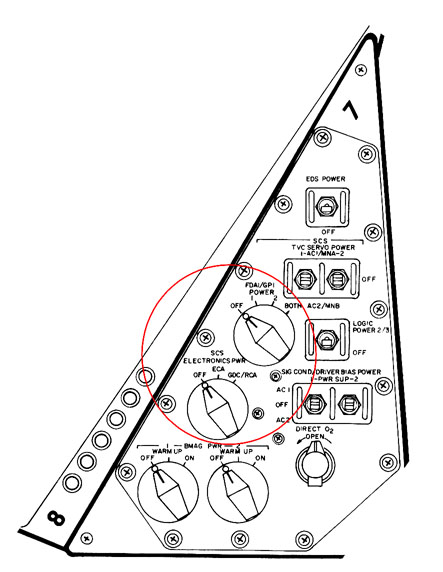
SCS Electronics Power and FDAI Power dials on Panel 7.
058:21:48 Lousma: ...Off. And all your Rotational Control Power, Off.
058:21:52 Swigert: It's done. Rotation Control Power, Direct, and Auto [garble], Off.
058:21:59 Lovell: Okay, Jack. Tell me there. We need to know when we're getting close to gimbal lock in the LM. We have no balls right now.
058:22:06 Lousma: Okay. We want you to power up your eight-ball. We want you to get your RCS heaters on. Pressurize the RCS and open up the Main SOVs. Over. [Pause.]
058:22:23 Haise: Okay, Jack. I got two Commander FDAI breakers in, AC and DC, and the two GASTA breakers in AC and DC and next you'll want the RCS heaters all on with the - pressurize the RCS and then the Main SOVs open. And I think they're already open.
058:22:40 Lousma: Roger. And, Freddo, get the TCA breakers in last. Please. [Pause.]
058:23:00 Haise: Roger, Jim. I'm holding open those until you give me a further word anyway. I'm just going to pressurize right now.
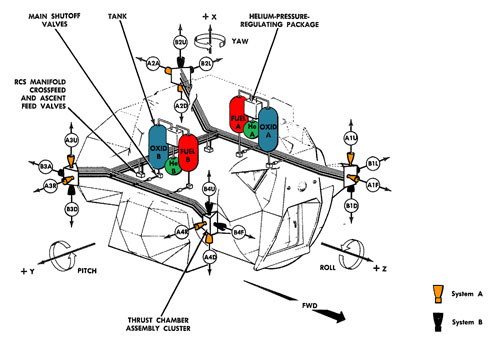
Lunar Module Reaction Control System diagram.
058:23:08 Lovell: Jack (Lousma), are you reading LM gimbal angles? [Long pause.]
058:23:38 Swigert: ...[Garble] power off, come down here and [garble] the audio [garble]. [Long pause.]
058:24:16 Lousma: Okay, Aquarius. I have some gyro torqueing angles and the Odyssey is powered down, attitude-control-wise, so LM's got attitude control now. [Long pause.]
058:25:13 Lousma: Aquarius, Houston. [Pause.]
058:25:21 Haise: Go ahead, Jack.
058:25:24 Lousma: Okay. We want you to know that we got some gyro torqueing angles for you. And we want you to tell us when you got attitude control in the LM.
058:25:38 Haise: Okay. We're still working on the pressurization. I'm getting Jim on the horn here so he can help out, there.
058:25:43 Lousma: Roger. [Long pause.]
058:26:09 Swigert: Wonder why.
058:26:14 Haise: We got to get this pressurized. [Long pause.]
058:26:55 Lovell: Houston, Aquarius.
058:26:58 Lousma: Stand by one, Aquarius, Odyssey. We'd like you to go Direct RCS and hold your present attitude out the window until the LM gets RCS powered up. Go ahead, Jim.
058:27:12 Lovell: Well, that's my question. We're not - Our 16 20 doesn't match our eight-ball here. We went to FDAIs On, and we don't have our balls completely powered up. There may be a [garble] and our angles don't look the same and we don't want to go into gimbal lock.
058:27:28 Lousma: Roger. How far are you from RCS power up - RCS pressurization? [Pause.]
058:27:45 Haise: Okay, Jack. I'm right up to where it's Master Arm, On; RCS, Fire;...
058:27:49 Multiple speakers: [Garble.]
058:27:50 Haise: ...both Logic Powers out [garble] goes into normal circuit-breaker [garble]. Do you want A in and then I'll fire them?
058:27:59 Lousma: Okay, 13. You're both talking at once. One at a time, please. [Pause.]
058:28:10 Swigert: Okay. Who's first?
058:28:11 Lousma: Close Logic Power A and B, Fred, and pressurize RCS.
058:28:17 Haise: Okay. [Pause.]
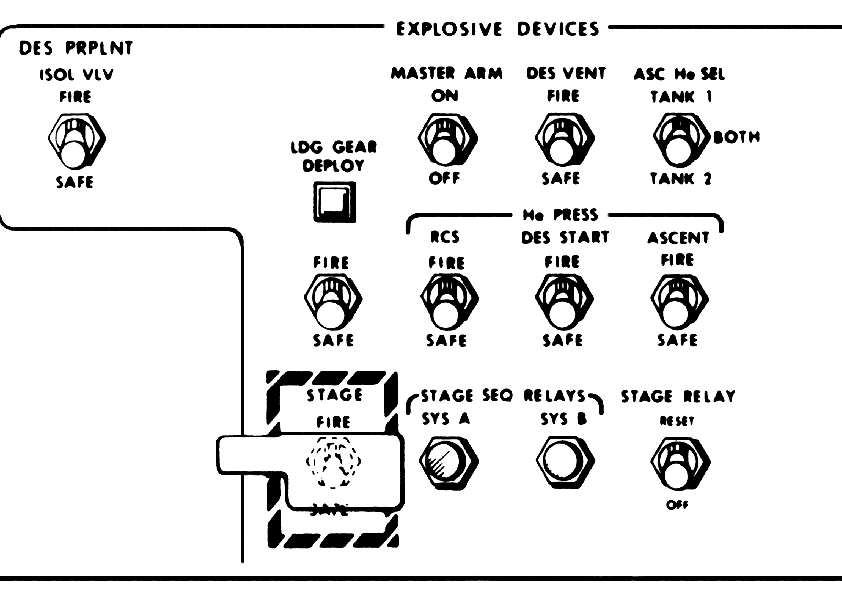
The Explosive Devices panel in the LM. Scan via heroicrelics.org
058:28:24 Lousma: Go ahead, Odyssey.
058:28:29 Swigert: Okay. I'm going to try to do the best I can. I've got a one-attitude reference I'm going to fly according to the lunar terminator.
058:28:37 Lousma: Roger, Jack. Just maintain attitude. [Long pause.]
058:29:04 Swigert: What am I doing? I can't do that, anyway. Let's see, cross feed. Nope. Now, and... [Pause.]
058:29:25 Lousma: Aquarius, Houston. We'll have to get some AC up so you can get a ball reading. Close your Bus Tie Inverter circuit breakers, all four of them on panel 11. Close your AC Bus Volt circuit breaker on panel 11. On panel 16, Inverter 2, Close. Select inverter 2. Over.
058:29:50 Lovell: That's been completed, Jack. [Pause.]
058:29:58 Haise: Okay. The RCS is pressurized now. [Long pause.]
058:30:39 Haise: Okay, Jack. Do you want us to proceed right on down the line with the RCS check-out and Activation 37 now?
058:30:51 Lousma: Stand by, Fred. [Pause.]
058:31:03 Haise: Hell, is he still firing up there? [Pause.]
058:31:15 Lousma: Okay, Fred. Negative on the activation on page 37. Go on to your RCS pressurize and then get your TCA breakers in and go to PGNS attitude hold. [Long pause.]
058:31:53 Lovell: Okay, Jack. How do you read?
058:31:56 Lousma: Okay, Jim. This is Houston. We want you to load the DAP with 30120.
058:32:06 Lovell: Load the DAP with 30120. Complete.
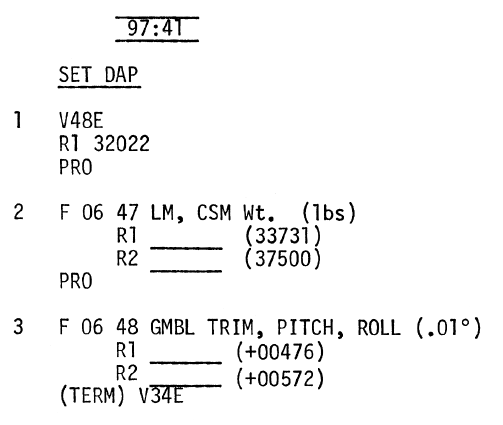
Associated page from the LM Activation Checklist that shows the Digital Autopilot startup.
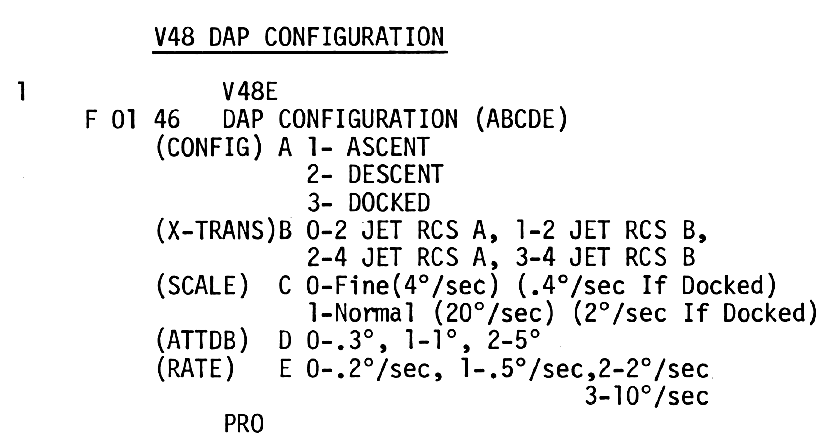
DAP configuration checklist from the LM Guidance and Navigation Dictionary.
058:32:16 Haise: Okay. We need to change that CSM weight.
058:32:25 Lousma: Okay, Aquarius. Your CSM weight is 63400. [Long pause.]
058:32:51 Lovell: And Jack's alive to take control the LM to stay away from gimbal lock. Over.
058:32:58 Lousma: Affirmative. Take control of the LM. PGNS Attitude Hold.
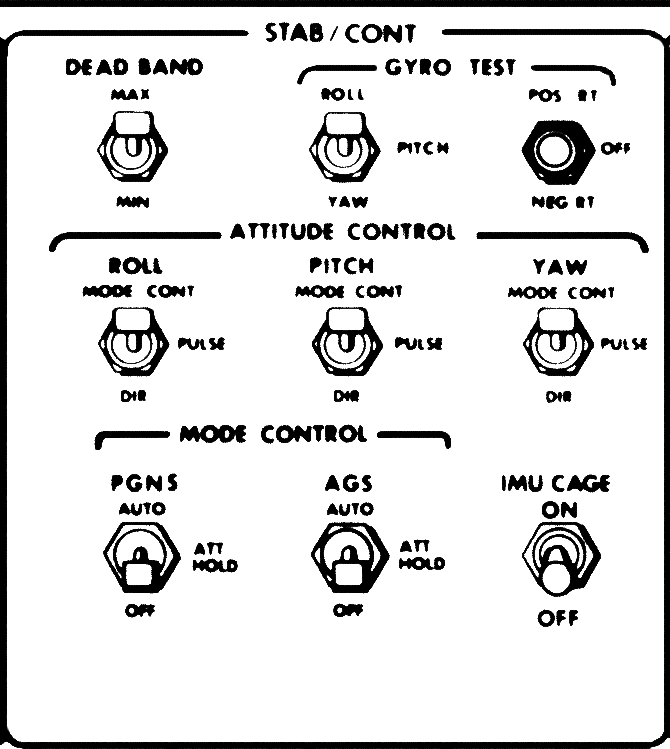
LM Stabilization/Control switches on the control console. Scan via heroicrelics.org
058:33:08 Lousma: And, Odyssey, request you coordinate with Aquarius on attitude control.
058:33:19 Lovell: Okay. I don't see where you're firing these things [garble].
058:33:27 Lovell: Are you firing anything?
058:33:28 Swigert: I don't think so. [Long pause.]
058:33:54 Lovell: Okay. I got Direct. [Pause.]
058:34:04 Lousma: And, Aquarius, check you ATCA (PGNS) breaker on panel 11 in.
058:34:13 Lovell: Say again.
058:34:15 Lousma: Close, on panel 11, circuit breaker ATCA (PGNS).
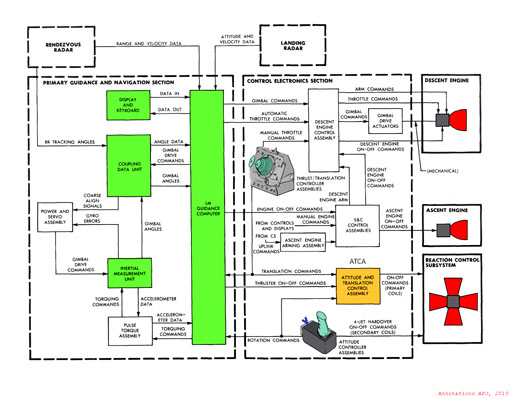
The Lunar Module Primary Guidance, Navigation and Control System, flowchart. Click image for larger view.
058:34:21 Lovell: ATCA (PGNS). Come on. Let's take it easy now.
058:34:30 Lovell: Okay. We've got ATCA (PGNS) closed.
058:34:32 Lovell: Is that okay?
058:34:35 Lovell: Okay. Now I'm looking.
058:34:37 Haise: [Garble] okay [garble]. [Pause.]
058:34:46 Swigert: How about plus?
058:34:48 Haise: No [garble].
058:34:49 Lovell: Okay. It's already open.
058:34:53 Lovell: Okay. Slow down.
058:34:58 Haise: Okay, Jack. We got it. [Long pause.]
058:35:21 Lousma: Okay, Jim. How's the attitude control?
058:35:27 Lovell: Okay, Jack. We've got attitude control now in the LM. We're going to try to rotate up through the bellyband.
058:35:38 Lovell: I like that sound like I got back there. [Long pause.]
058:35:59 Lousma: Odyssey, Houston. I've got a procedure for you.
058:36:05 Swigert: Okay, Jack. I'm [garble].
058:36:09 Lovell: I want to go up this way to get away from that - the radios are powered, huh?
058:36:16 Swigert: Yes. [Long pause.]
058:36:33 Lovell: Check your antenna?
058:36:37 Swigert: Okay, Jack. Odyssey is ready to copy.
058:36:40 Lousma: Okay, Jack. What we want you to do is close the reactants valve on fuel cell 2. Power down your inverters. Power down your battery relay bus. Battery ties, off, and pull your entry circuit breakers, entry battery circuit breakers A, B, and C. [Pause.]
058:37:15 Lovell: Check the control, and make sure we don't go to gimbal lock, Fred.
058:37:21 Swigert: Okay, Jack; understand. Close Reac valve circuit breakers in fuel cell 2. Power down inverters. Power down Bat relay bus. Bat TIES, Off. Power entry and both running circuit breakers A, B, and C. All off.
058:37:41 Lousma: That's affirmative, Jack. And close the reactant valve on fuel cell 2, there.
058:37:50 Swigert: Okay. I'll do that, and Jack'll do that other.
058:38:02 Lousma: Okay, Jack; on fuel cell 2, open circuit it. [Long pause.]
058:38:18 Swigert: Okay. Fuel cell 2 is open circuited. Do you want me to go through the standard shutdown procedure for the Reac valves and... [Long pause.]
058:38:37 Lousma: Odyssey, Houston. All you have to do is close the Reacs valve on fuel cell 2.
058:38:42 Swigert: Okay. CB Reacs and vent Reac valves all closed. [Long pause.]
058:39:24 Swigert: Yes. [Long pause.]
058:39:58 Haise: [Garble] an hour and a half.
058:40:06 Lovell: Houston, Aquarius.
058:40:09 Lousma: Go ahead, Aquarius.
058:40:12 Lovell: Okay. Odyssey is completely powered down, according to the procedure that you read to Jack.
058:40:22 Lousma: Roger; we copy. That's where we want to be, Jim. [Pause.]

Panel 250, Circuit Breakers
058:40:36 Haise: And, Jack, have you all got good LM data down there now? [Pause.]
058:40:47 Lousma: That's affirmative, Fred. We're getting good LM data.
058:40:53 Haise: Okay. In that case, I think I'll pull out some display breakers and just let you all keep an eye on things.
058:41:04 Lovell: He's turning his lights off now, too.
058:41:06 Lousma: Stand by one on that, Fred. [Pause.]
058:41:21 Lovell: What about these lights up here?
058:41:30 Haise: I've got it.
058:41:34 Haise: Where would you like [garble]?
058:41:37 Lovell: [Garble] [Pause.]
058:41:47 Haise: Oh. [Long pause.]

A serious Glynn Lunney in Mission Control. NASA film capture. NARA.
Lunney (FLIGHT): Okay, everybody, look. We've got a number of long-range problems right now. We have the burn to do, which is at about 79 hours: 28 hours from now. And that's one business. We have to get the track up as we need it to take care of that burn. Hopefully we won't need to do too much with that, although I don't know how many amps that's going to take. However, right now, I want to be sure that we get the whole situation stabilized with the LM and the CSM. We've got to start bringing the LM power down some, and get any non-required stuff off the line so we don't use up any of these amp-hours that we don't need to give away. And I want you to pay attention to the configuration we're currently in and get the people offline working on the longer-range problems, especially the lifeboat problems now associated with the LM. You know, LiOH, etc. Let's get all that configured. But right now I want the guys who are in the room to concentrate on keeping this thing right now going along all right, and watching it... Alright.
058:42:41 Lovell: We don't want to lose Comm with him.
058:42:45 Haise: I'm watching it.
058:43:52 Lousma: Aquarius, Houston. Stand by on opening your circuit breakers for displays. We're going to let you know what they are, and I have some gyro torqueing angles for you. [Pause.]
058:44:10 Lovell: Okay. What page is that there gyro torqueing?
058:44:12 Haise: Okay. What page is the, do we write the gyro torqueing angles on there, Jack?
058:44:17 Lousma: Stand by.
058:44:18 Haise: Okay. We're there now, Jim. Jim's got it. Go ahead with the gyro torqueing angles.
058:44:24 Lousma: Okay. We'd like you to proceed with the fine align and your gyro torquing angles are X plus 003.30, Y plus 024.80, Z minus 015.10. Over. [Pause.]
058:44:48 Lovell: Okay. I read your gyro torqueing angles as plus 003.30, Y is plus 023, I only have four numbers for Y; you'll have to give that one to me again, and Z is minus 015.10. Read Y again, please.
058:45:06 Lousma: Okay, Jim. X and Z are correct and Y is plus 024.80. [Pause.]
058:45:19 Lovell: Okay. We read Y as plus 024.80. We'll proceed on Activation 40 to fine align the platform.
058:45:28 Lousma: Roger. Okay, Aquarius, proceed as on page 40 with IMU fine align.
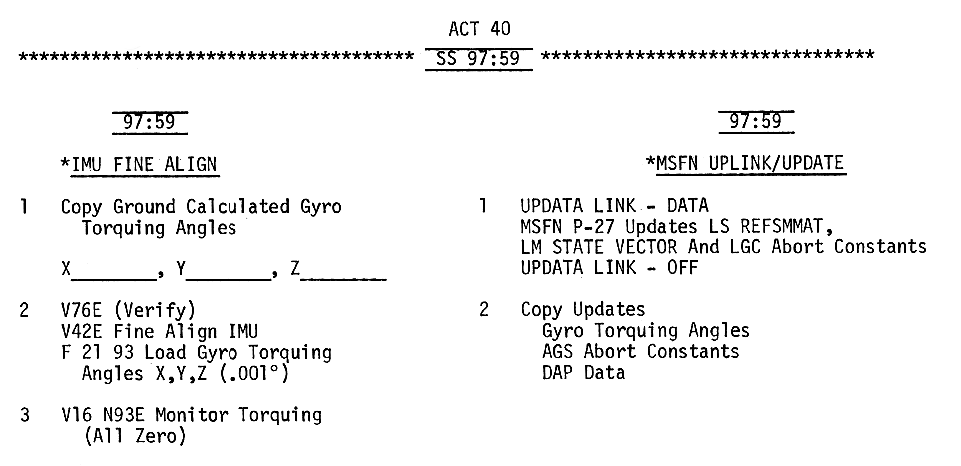
Fine Align procedure in the LM Activation Checklist, page ACT-40.
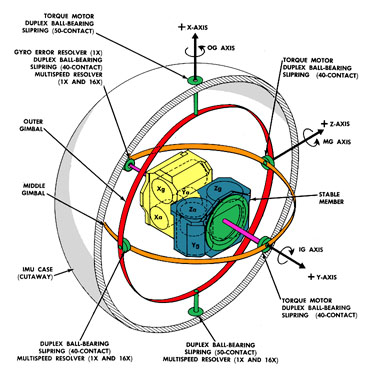
The Apollo IMU gimbal platform.
"This is Apollo Control; 58 hours, 46 minutes Ground Elapsed Time. Lovell and Haise still powering up the Lunar Module, getting attitude control, aligning the platform, in preparation for what turns out to be an alternate mission in which no lunar landing will be possible. However, the spacecraft will fly around the Moon. At this point in translunar coast, it is more economical in propellant and time to continue to coast on around the Moon and come back to Earth interception trajectory. In about 20 minutes in the Houston News Center there will be a press conference in the small briefing room. Stand by.
058:47:41 Lousma: Aquarius, Houston. Can you see any stars out the LM window? [Pause.]
058:47:53 Haise: We'll have to wipe them off, Jack. They're coated with water right now.
058:47:59 Lovell: Can I get a towel?
058:48:01 Lousma: Roger. As soon as you get a chance to - on your position - to take a look, we'd like to know if you can see stars for alignment purposes.
058:48:16 Haise: Okay. Jim's going to be in trouble in our present attitude out his side. The Sun's there.
058:48:25 Lovell: Wait 1.
058:48:29 Haise: What have you got? How much you got left in battery A? Okay. I wish I knew what the hell they were thinking right now [garble]...
058:48:51 Lovell: They're talking about powering down and doing a P51 here?
058:48:57 Haise: No. They were just thinking about P52...
058:49:00 Lousma: Aquarius, Houston. Negative on the P51. We want to stay just like we are, but we'd like to be able to correlate what you're doing with some simulator work we're going to crank up. And so if you can give us information as to what stars you can see out the window, we can make that correlation.
058:49:22 Lovell: Would you say one more time? Give me the top two. The top two. [Pause.]
058:49:33 Lousma: Jim, what we want you to do is go with your current fine align and disregard the P51. What we're attempting to do is to crank up some LMS simulations to correlate what we can get out your window with what we can get out the LMS window to see if that will help us any. So when you can see some stars, if you can, you think you can recognize them and recognize constellations, please let us know.
058:50:02 Lovell: Okay. We'll check. Stand by. [Pause.]
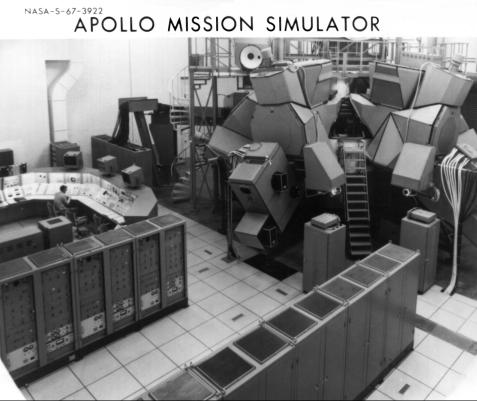
The Lunar Module Simulator facility.
Participants in the forthcoming press conference within the next 15 minutes or so will be Manned Spacecraft Center, Deputy Director Christopher C. Craft, Jr., Apollo Spacecraft Program Office Manager James A. McDivitt, and MSC Director of Flight Operations, Sigurd Sjoberg. This will be in the small briefing room in the Houston News Center. We'll be isolated from the air-ground which will be continually fed in real time to the News Center.
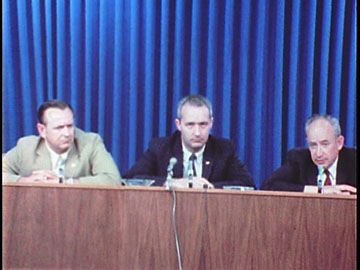
Christopher C. Kraft, James McDivitt and Sigurd Sjoberg at the news conference. NASA film capture. NARA.
058:50:16 Lovell: Okay. Watch the... [Long pause.]
058:50:45 Swigert: I'm just glad [garble]. [Long pause.]
058:51:25 Lovell: Okay, stand by. [Long pause.]
058:51:40 Lovell: Okay. Here, unplug this. [Long pause.]
058:52:13 Lousma: Aquarius, Houston. We notice that the O
2 pressure in the Ascent Tank O
2 is a little high, so we want to use some of it. So close Descent O
2 and open Ascent O
2, tank 2. Over. [Long pause.]
058:52:45 Haise: Okay, Jack. Switch now on Ascent number 2 O
2 tank, Descent O
2 is closed.
058:52:53 Lousma: Roger, Fred. [Long pause.]
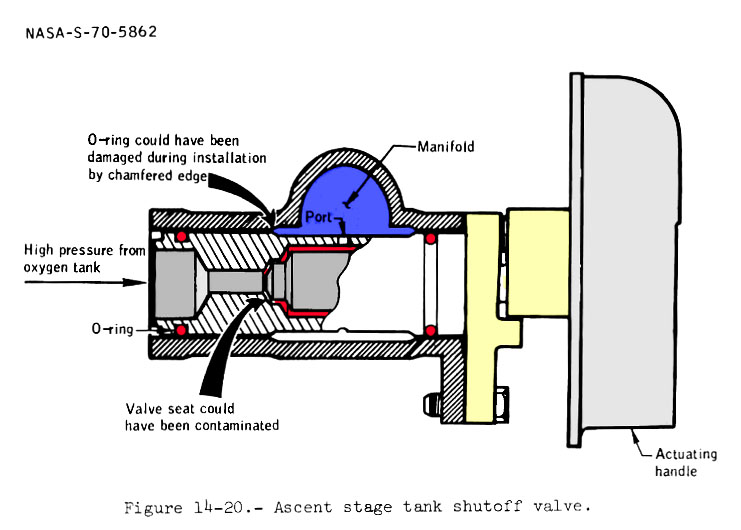
Ascent O2> tank valve and internal structure.
058:53:39 Lovell: [Garble] that? [Long pause.]
058:54:01 Lovell: Okay, Houston; Aquarius. How do you read?
058:54:05 Lousma: Reading you 5 square, Jim. Go ahead.
058:54:09 Lovell: Okay. I'm looking out of Fred's window. I see a lot of particles out there, but a lot of that stuff is still drifting away from us, so a lot of it is flashing in the local vicinity, and I don't recognize any constellations right now, in this particular attitude. [Pause.]
058:54:34 Lousma: Okay, Jim. If that status changes, please let us know.
058:54:41 Lovell: Roger. We're continuing to drift. Okay, get your TTCAs to roll.
058:54:54 Haise: TTCA [garble]. [Pause.]
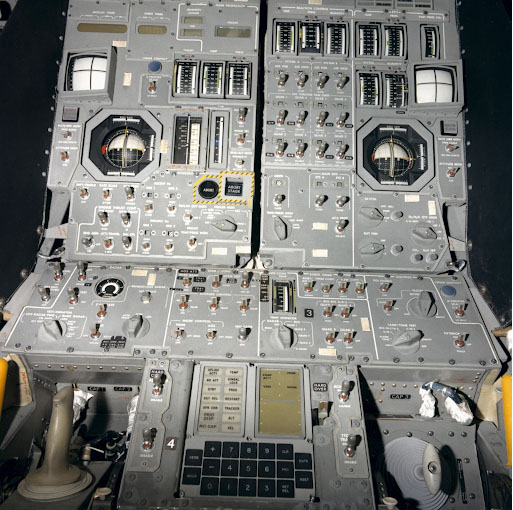
Pre-closeout picture of the Apollo 12 LM showing the Commander's ACA and the Lunar Module Pilot's TTCA hand controller.
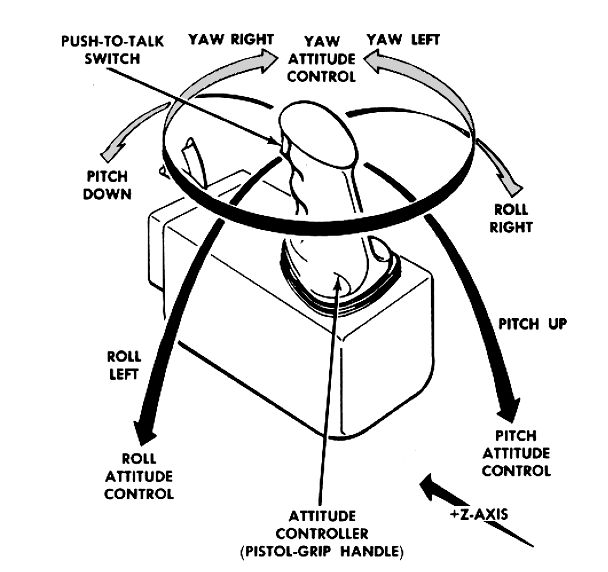
Diagram of the Attitude Control Assembly.
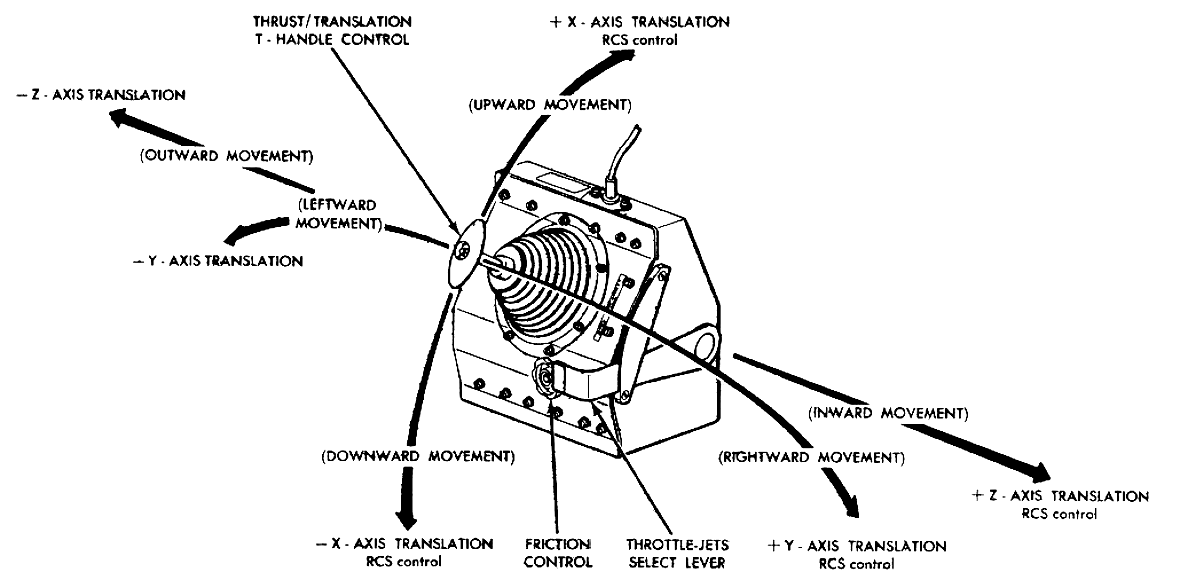
Diagram of the Translation and Thrust Control Assembly.
058:55:08 Lousma: And, Aquarius; Houston. I've got some circuit breakers you can open to power down displays. In addition, I have a P30 maneuver PAD. Over.
058:55:20 Lovell: Roger. Stand by, Houston. Get the CS ... get the PAD book.
058:55:28 Haise: Get the LM data - get the LM book.
058:55:32 Lovell: And, say - We're getting the PAD book now, Jack - and say the boost on powered up?
058:55:38 Lousma: Okay. I have some circuit breakers that you can open up in order to power down displays.
058:55:45 Haise: Okay. Stand by one, Jack. I'm going to get my comm carrier on you can open to power down
058:55:54 Lovell: All right, I'll tell you what. Get all the LM stuff. Give me the LM stuff right now. Jack, give me all the LM stuff. [Long pause.]
058:56:45 Lovell: Why? [Long pause.]
058:57:06 Lovell: All right, Jack. Hey, what do you need out of here ?
058:57:13 Swigert: [Garble] status.
058:57:19 Lovell: Here. [Long pause.]
058:58:12 Lovell: Now is there any way they can control this thing with the LM on? Freddo?
058:58:20 Haise: What's that?
058:58:21 Lovell: Looks like I'm cross-coupling here. I might as well...
058:58:23 Haise: Yes, you are. TTCA will give you the best controlling warning.
058:58:30 Lovell: Yes, and I want to get out of this roll. What if I go to... [Pause.]
058:58:42 Haise: It doesn't matter where the hell you are [garble]. Gimbal lock [garble] my flashlight or any flashlight. [Long pause.]
058:59:16 Haise: [Garble] down and power down [garble]. [Long pause.]
058:59:34 Lovell: Well, I'm not doing any good here.
058:59:38 Haise: Okay, how do you read now, Jack?
058:59:46 Haise: Yes, we're on.
058:59:51 Lovell: Hello, Houston; Aquarius.
058:59:54 Swigert: Back on? Yes. [Pause.]
059:00:04 Lousma: Aquarius, Houston. You're watching the middle gimbal there, aren't you? Go ahead, Aquarius.
059:00:12 Haise: Okay. Go ahead with the breakers first, Jack.
059:00:15 Lousma: Okay. You watching your middle gimbal there?
059:00:20 Lovell: Tell them we are.
059:00:24 Haise: Your attitude is just straight pitch down, Jim. Okay, you're moving away. [Long pause.]
059:00:48 Lousma: Okay, Fred, I've got six circuit breakers for you.
059:00:54 Haise: Okay. Go ahead.
059:00:56 Lousma: Okay, they're all on panel 11. Row 1 under AC Bus B, open Helium PQGS for Propellant Display.
059:01:07 Lovell: It's Open.
059:01:09 Lousma: On row 2, Flight Displays, open Thrust, open Mission Timer, open Range/Range Rate, Altitude/Altitude Rate, and open the AC Bus A Range Rate, Altitude/Altitude Rate.
059:01:25 Lovell: They're Open.
059:01:26 Haise: Okay. They're all Open.
059:01:27 Lousma: Okay. On row 4, PGNS, Signal Strength Display. [Pause.]
059:01:38 Lovell: It's Open.
059:01:39 Haise: It's Open.
059:01:42 Lousma: Okay. That concludes the power-down of displays. And I have a P30 PAD for you. [Pause.]
059:01:53 Haise: Okay. Go ahead.
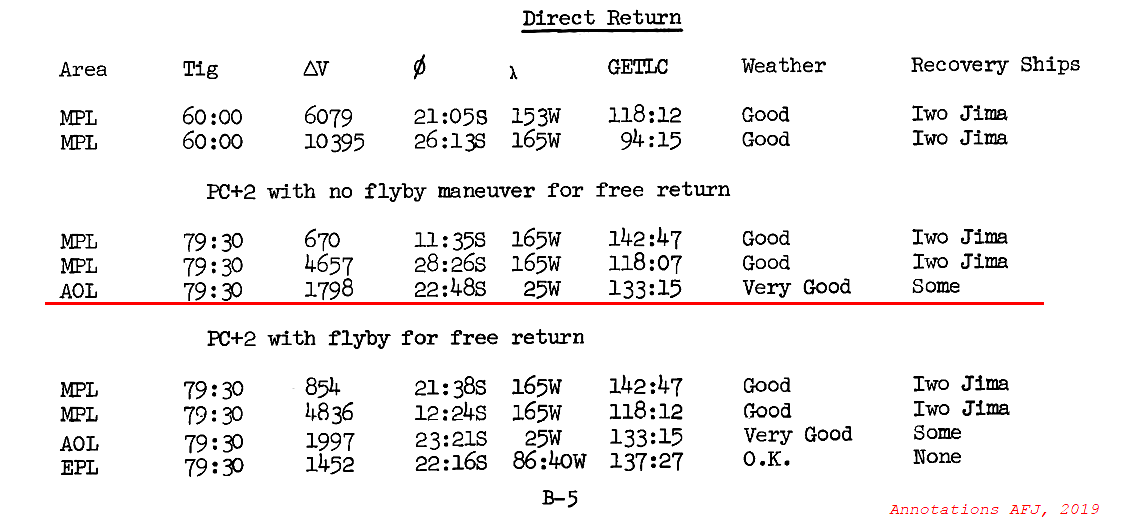
Trajectory options calculated for the return of Apollo 13 immediately post-accident. The option read up the crew is underlined.

Spheres of influence in the Earth-Moon system.
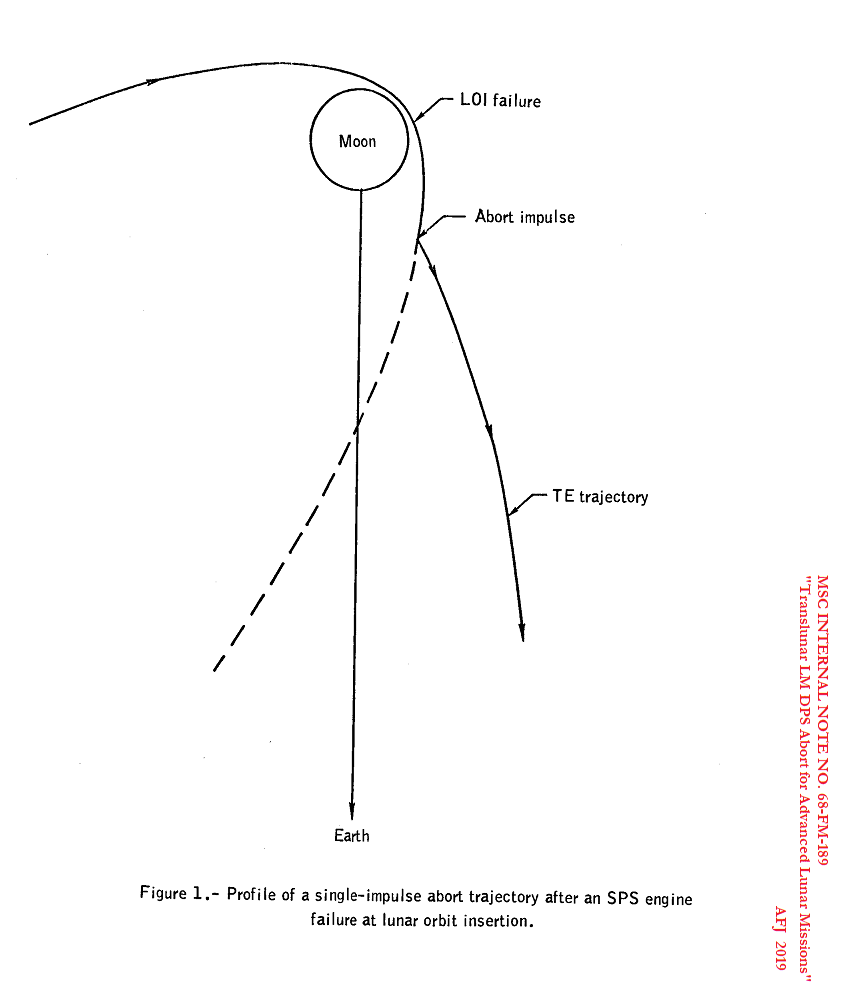
This simple diagram shows the PC+2 DPS maneuver in the August 1968.
059:01:57 Lousma: Okay. The purpose is a pericynthion plus 2 hours DPS abort. Noun 33: 079:25:26.48; plus 1633.0, minus 0014.5, minus 0751.5; apogee not applicable, perigee is plus 0020.5; 1797.7, 8:35, 268, 264, plus 16410, minus 00145, minus 07338. COAS is NA. And I have two gimbal trim angles for you which will be updated. Right now, however, we want you to go with pitch 5.86, roll 6.75. Over.
059:03:37 Haise: What was that for?
059:03:40 Lovell: Pitch and yaw, maybe, huh?
059:03:42 Haise: Okay, what was the last two things you gave me, a pitch and roll angle for what?
059:03:47 Lousma: That's for your DPS trim.
059:03:48 Lovell: Those were gimbal angles for - pitch and yaw.
059:03:54 Haise: Oh, Roger. GDAs.
059:03:56 Lousma: Yes, that's what I mean. Sorry.
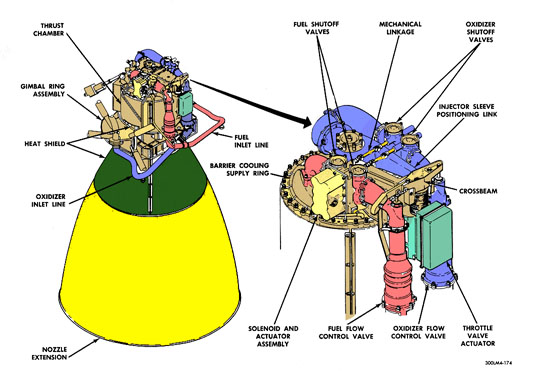
The Descent Engine.
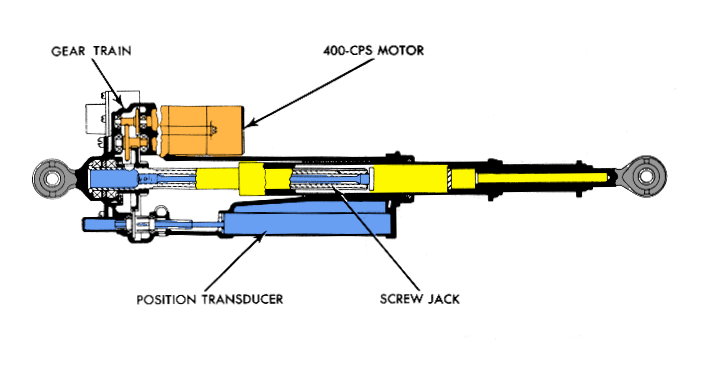
Gimbal Drive Actuator. Electric motors run a screw mechanism that moves the engine nozzle on two axes of freedom.
059:03:58 Haise: Pericynthion plus 2 - Okay, DPS pericynthion plus 2, at 079:25:026.48; plus 1633.0, minus 0014.5, minus 0751.5; HA N slash A, HP plus 0020.5; 1797.7, 8:35, 268, 264, plus 16410, minus 00145, minus 07338...
059:04:43 Lovell: Did we lose the water in the...
059:04:44 Haise: ...N slash A in the COAS, and you gave me GDA angles of pitch 5.86, and you want roll 6.75.
059:04:56 Lousma: Good readback, Fred.
059:05:00 Lovell: Yes, lose - get all the little bags you can with water.
059:05:06 Lousma: Aquarius, Houston. Say again, please.
059:05:13 Haise: Okay. We didn't answer back there, Jack. Check to see if you're on VOX.
059:05:22 Haise: Neither am I, okay. Why the hell are we maneuvering at all now? Are we still venting?
059:05:34 Lovell: Well, we're at Att Hold for one thing - I mean, we're at Minimum Impulse.
059:05:38 Haise: No, I mean why can't you null them out, somewhere?
059:05:41 Lovell: Every time I try to - I can't take that doggone roll out. I got to wait until they get around to the bellyband.
059:05:50 Haise: Wait a minute. Do you - you fight roll by using the TTCA left right. That's what you need to play with.
059:06:04 Lovell: Okay. We'll try that. Let me get around though. Let's roll. Let it roll all the way.
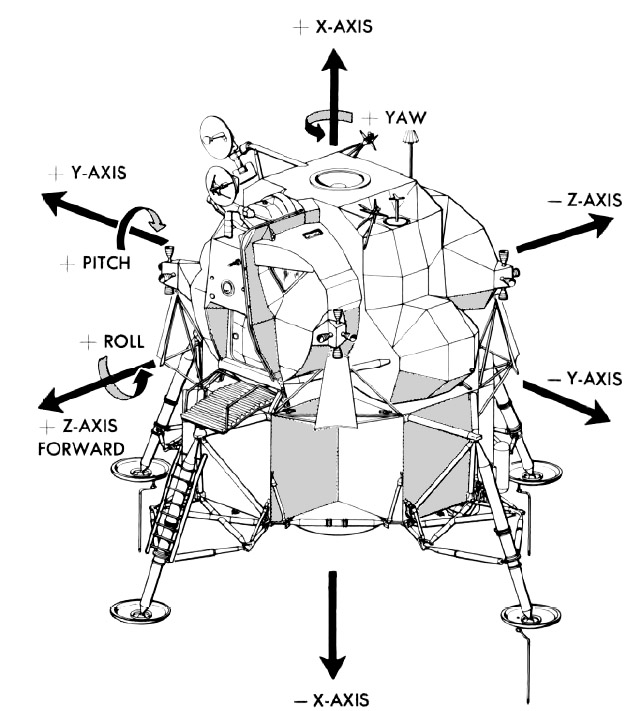
The LM axes of motion
059:06:12 Haise: Yes, you can't let it roll all the way.
059:06:13 Lovell: I know. I know. But I mean...
059:06:16 Haise: Okay. Then until it's upside down at least, huh?
059:06:19 Haise: Okay. Well, should I ask him what the return time on that one is? Or are you interested?
059:06:31 Lovell: Let's get the first things first. [Pause.]
059:06:43 Haise: Oh, you don't want to hear. Let me figure some times out here. That's at 79, and what are we at now? About - do we - do we - do we even know any better computer time, do we?
059:07:00 Haise: Hey, Jack. Do you still have a mission timer? You don't? Okay.
059:07:07 Lovell: I'll tell you what. Let's ask - let's ask Houston to give us a mission timer, computer time. They can up link it to us. Okay, hold it.
059:07:18 Haise: Go ahead.
059:07:20 Lovell: Houston, Aquarius.
059:07:21 Lousma: Go ahead, Aquarius.
059:07:25 Lovell: You know, we don't have a - I don't think we have a computer clock going, and why don't you up link that stuff to us?
059:07:31 Lousma: Roger. [Pause.]
059:07:40 Lousma: And, Freddo, I got some fast circuit breakers on panel 16 for you.
059:07:49 Haise: Okay. Go ahead.
059:07:51 Lousma: Okay. On row 1 under Flight Displays, Systems Engineer's Crosspointer, Open. Under RCS B...
059:08:00 Haise: It's Open.
059:08:01 Lousma: Open the Temp/Press Display-Flags and PQGS/Displays.
059:08:10 Haise: Okay. They're both Open.
059:08:12 Lousma: Okay, Fred. On row 3 under Comm, open Displays and under ECS, open Displays. [Pause.]
059:08:25 Haise: Okay. Comm Displays, ECS Displays, both Open.
059:08:28 Lousma: Okay. And two more. In row 4 under Heaters, open Displays and under EPS, open Displays.
059:08:40 Haise: Okay. Heaters Display, EPS Display Open. And I've long since had all the lights off, floods, et cetera. [Pause.]
059:08:55 Lovell: Where are those bags? Where are those bags for weighing water in the PLSS?
059:09:03 Lovell: We're going to fill up Command Module water. We'll [garble].
059:09:09 Haise: Hell, do you need a QD [clipped] Jim. No way to get ours in there. I don't think. [Long pause.]
Lunney (FLIGHT): Why don’t you give them a GET hack though, eh? And let them know we hear that VOX.
059:09:37 Haise: Hey, Jim. [Pause.]
059:09:44 Lovell: I wonder if one of our water [garble] jet is. Okay, let's control - What else can we fill up there?
059:10:00 Lousma: Aquarius, Houston.
059:10:02 Haise: We're not - we're not going to...
059:10:03 Lousma: We're not going to be able to up link your time because of the IU, and we have a frequency problem there. But what I'd like to do is give you a time to set up on your mission timer and give you a mark and then you can put it into the DSKY from there. Over.
059:10:25 Lovell: Okay. Stand by.
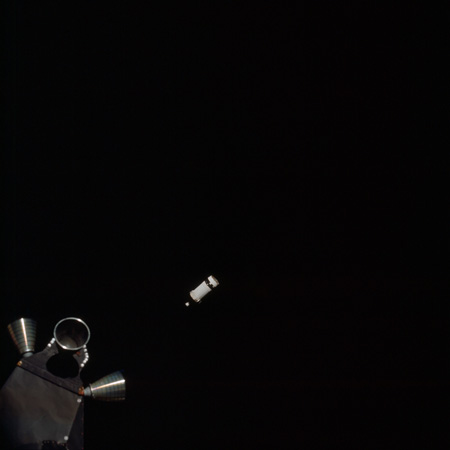
AS13-60-8585 - Apollo 13's spent S-IVB stage drifting away after separation. Color correction by David Woods. Image credit: Image Science and Analysis Laboratory, NASA-Johnson Space Center.
059:10:27 Haise: Wait a minute. Why do we need a mission timer right now, anyway? I mean, that bad, they'd tell us.
059:10:32 Lovell: Well, I'd rather have a timer going so that we - what are we going to put in the DSKY? Should we shut down the mission timer?
059:10:37 Haise: Is that what you want to do?
059:10:38 Lovell: Yes. Hey, Omni.
059:10:47 Lovell: Switch them. Okay. Let's fire on the mission timer. [Pause.]
059:10:59 Lousma: Aquarius, we need Forward Omni.
059:11:05 Lovell: Forward Omni.
059:11:07 Haise: Say again, Jack.
059:11:09 Lovell: Forward Omni.
059:11:11 Haise: I am. Okay, Houston. If that call was an Omni switch, I'm in Forward now.
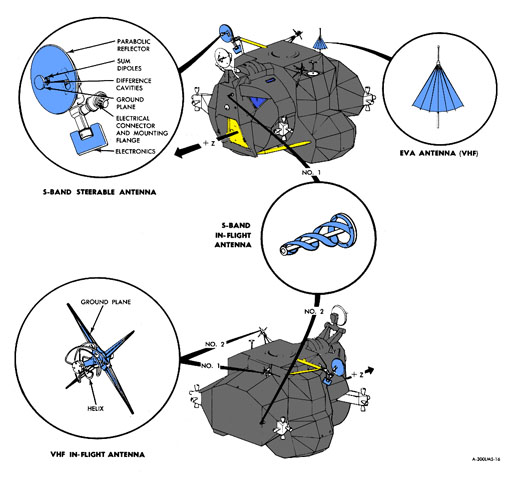
Lunar Module communications antenna locations.
059:11:28 Lovell: Okay, Freddo, how do I get the mission timer up? I got the mission timer cranked in.
059:11:34 Haise: You got it on?
059:11:35 Lovell: I got the mission timer circuit breaker in.
059:11:38 Haise: Okay. We're going to probably need Numerics Lighting. There you go. You got it.
059:11:47 Lousma: Aquarius, Houston. I think we've got a better way of getting your mission time up.
059:11:56 Lovell: Go ahead with it.
059:11:59 Lousma: Okay. We can do a Verb 55, Enter, and then put an R1, minus 00088. In R2, minus 00059; R3 minus 03274.
059:12:28 Haise: Watch the crapping attitude.
059:12:31 Lovell: We're okay.
059:12:36 Haise: God damn. I wish you'd get to something I know.
059:12:41 Lovell: Well, as soon as we get over here, we'll stop it with the TTCA.
059:12:46 Lousma: And, Aquarius; Houston. We've got you both on VOX.
059:12:54 Haise: Like to go what?
059:12:56 Lovell: You want us on VOX, Jack?
059:12:58 Lousma: We have you on VOX. We're reading you loud and clear and the clock took good. [Long pause.]
059:13:17 Haise: Okay. Looks like we're on the FDA route there, Jack. [Long pause.]
059:13:39 Haise: Okay, Jack. How do you read me on Normal Voice now?
059:13:42 Lousma: Reading you 5 square, Fred.
059:13:46 Haise: Okay. [Long pause.]
059:14:12 Lousma: And, Aquarius, we're ready for a Verb 74 when you can give it to us. [Pause.]
059:14:23 Haise: You got it.
059:14:25 Lousma: Okay. And one other thing we noticed. When you pressurized the RCS, we got an increase in pressure in the ascent tanks, and so we want to have you verify that the ascent feeds are closed. In order to do that, on panel 11, close the Ascent Feed 1 and 2 circuit breakers on - and cycle the Parker valves, and then open the Ascent Feed circuit breakers on panel 11. [Pause.]
059:15:08 Lovell: Completed, Houston.
059:15:10 Lousma: Okay, Jim. Thank you.
059:17:53 Haise: And, Jack, Aquarius. What kind of return time is this maneuver given?
059:18:02 Lousma: That puts you back in the water at 133 hours.
059:18:11 Haise: 133, hey.
059:18:13 Lousma: Affirm. [Pause.]
059:18:24 Lousma: And that's an Atlantic landing site.
059:18:31 Haise: Atlantic landing?
059:18:36 Lousma: Affirmative. That's the PAD that we've given you, but we may change our mind later on. We want you to have this info for now. And that's a minimum...
059:18:48 Lousma: ...minimun time return.
059:20:09 Lousma: Aquarius, Houston. We've got to change the REFSMMAT to the one to which you're aligned. So we'd like to have P00 and DATA and we'll ship that up to you.
059:20:21 Lovell: Roger. [Pause.]
059:20:30 Haise: Okay, you got it, Jack.
059:20:34 Lousma: Roger. Coming up. [Long pause.]
059:21:22 Lousma: Aquarius, could you give us DATA please? [Pause.]
059:21:32 Lovell: Okay, Jack, you got it.
059:21:33 Haise: ...the updata link, the DUA breaker may not be in, Jack.
059:21:44 Lousma: Okay, Fred, and close the DUA breaker.
059:21:51 Haise: It's in now, Jack.
059:21:54 Lousma: Okay, Jim, and it's coming up now. Thank you.
059:28:03 Lousma: Aquarius, Houston. We're finished with the uplink. The computer is yours. We'd like to power down the DUA, so pull the DUA circuit breaker please.
059:28:14 Haise: Okay. Updata link breaker is coming Open.


